Paris-Nice has signaled the arrival of spring and the serious start of the European stage race season and it doesn't get any less intense and exciting when the second part of the traditional doubleheader of early-season WorldTour stage races kicks off in Italy. Once known as a punchy race for classics riders and the perfect preparation for the biggest one-day races, the event has changed its nature and is now a mini grand tour that has attracted the biggest stage race stars in recent year. A challenging course will test every aspect of the riders’ skills and even though the line-up is not as star-studded as it was one year ago, a formidable list of grand tour stars will battle it out in a race whose prestige seems to be growing from year to year.
Most professional bike riders already have plenty of racing miles in their legs, making good use of the warm and sunny conditions in places like Australia, Argentina, the Middle East, Algarve, Andalusia, and the French Cote d'Azur to clock up the kilometres. While an early win is always appreciated and a welcome boost of confidence, however, it has until now been all about warm-up and preparation for the bigger races to come.
That changed last weekend when the professional cycling calendar entered its next phase with the traditional Belgian opening weekend. While cycling fans all over the world have appreciated the globalized cycling and the many high-level early season events, there is still a feeling that the season hasn't started for real until the best classics riders have tested themselves on the Belgian cobbles for the first time.
Omloop Het Nieuwsblad kicked off the race calendar of historic races on European soil. From now on, the races are no longer mere training in a laid-back atmosphere, now it is time to clock up the results. For the classics riders, things got serious last Saturday but for the stage race riders, the first real test has traditionally come with the double-header of big, historic stage races: Paris-Nice and Tirreno-Adriatico. Even though Paris-Nice is not the Tour de France and Omloop Het Nieuwsblad is not the Tour of Flanders, the serious racing now begins in earnest.
Paris-Nice and Tirreno-Adriatico both play a strange, dual role on the calendar. On one hand, they are the first big objectives for the greatest stage racers who hope to land their first big wins in one of the most prestigious races on the calendar. At the same time, they are a crucial part of the preparation for the classics riders who benefit immensely from one week of WorldTour racing in tough conditions and versatile terrain. It may be difficult to decide whether to head to France or Italy but one of the races forms an indispensable part of every successful classics schedule - just ask Team Sky whose classics riders made the ill-fated experiment of skipping the historic stage races in 2013.
First held in 1966, Tirreno-Adriatico lacks the deep history of Paris-Nice but it is no wonder that it has overcome this fact to quickly become a major event on the calendar. Known as the Race of the Two Seas, it follows a route between the Tyrrhenian and Adriatic coasts and thus takes the riders through some very hilly terrain in the Italian mainland. The climbs in this area are not necessarily very long but their short, steep nature and the always undulating profiles make the race a perfect fit for any classics rider looking for form. If one adds the often pleasant weather conditions, one has the recipe for a success that has been able to battle for attention with the longer history of Paris-Nice.
The race quickly grew into a major event and already in the 7th edition in 1972, Belgian classics legend Roger De Vlaeminck started an impressive string of successes that saw him win the race 6 years in a row. Even though the winners list remains dominated by Italians, it has always been an international affair that has attracted the interest of the best classics riders, with many of them having won the race at least once.
Tirreno-Adriatico lacks the symbolic nature of the Paris-Nice which signals the arrival of spring by travelling from the cold of Northern France to the sun at the Cote d'Azur but for a rider looking for form, there is no need to go through those cold, windy days in the North. The better weather has always been a major draw card for the Italian race in its constant battle with its French counterpart for the strongest line-up.
In fact, the two races have shared the best riders rather nicely between them. With time trials and longer climbs, Paris-Nice has often attracted the best stage race riders while the lumpy natures of the courses in central Italy and often very long stages have made the Italian race a perfect fit for the classics riders. In recent years, the race has been won by riders like Michele Bartoli, Davide Rebellin, Erik Dekker, Filippo Pozzato, Paolo Bettini, Oscar Freire, and Fabian Cancellara while the grand tour specialists have been battling on the roads of France. As a consequence, Tirreno has won the battle of being the best preparation event for Milan-Sanremo and it is no wonder that most of the winners have arrived in Sanremo on the back of a solid showing in Tirreno.
In recent years, however, things have changed. Instead of continuing to attract the classics stars, organizers RCS Sport have tried to make the race into more of a mini grand tour. The latest editions have both included team and individual time trials and major summit finishes and they have gradually attracted more and more grand tour riders to their event. With the better weather and a course now suited to their characteristics, also the stage race riders have preferred to travel to Italy instead of going to France.
In 2014 Paris-Nice organizers ASO made a new move in the battle between the two races that saw the roles of the two races getting swapped. With no major summit finishers and no time trials at all, they put together a course that was described as eight consecutive classics. As Tirreno decided to keep its new format as a mini grand tour, it was no wonder that many stage race specialists changed their minds and headed to Italy instead of France. On the other hand, several classics rider were tempted by the prospect of winning a stage or two on the way to Nice and decided to change their usual early-season schedule.
The move didn’t pay off for ASO. While Alberto Contador and Nairo Quintana took all the attention with their great battle in Italy, the French race didn’t get its usual attention. In an attempt to again attract the major grand tour stars, Paris-Nice has returnedto its traditional format and last year the French race was the hardest of the two. Due to the uncertainty, however, the biggest stage racers mostly decided to go to Tirreno-Adriatico andagain the Italian race could field a formidable line-up that was led by the four grand tour giants Alberto Contador, Vincenzo Nibali and Nairo Quintana. However, Contador slightly regretted the decision, claiming that the Paris-Nice course is better for a climber like him.
This year Paris-Nice have continued to follow the trend of making their race suited to grand tour rider again and this year the French race is again very hard. Tirreno-Adriatico stick to the well-known formula but as the two races are now competing more on equal terms, the stage race riders are spread more equally across the two events. While Contador and Richie Porte lead a strong line-up in France, Vincenzo Nibali, Thibaut Pinot, Alejandro Valverde, Joaquim Rodriguez, Bauke Mollema, Michal Kwiatkowski, Tejay van Garderen, Esteban Chaves, Wout Poels, Rigoberto Uran, Domenico Pozzovivo, Daniel Martin and Jean-Christophe Peraud spearheads the list of GC contender in Italy.
Furthermore, Paris-Nice is gaining ground as the preferred preparation race for Milan-Sanremo. The last two winners have both prepared in France and it seems that more and more sprinters are heading to France. Nontheless, riders like Peter Sagan, Greg Van Avermaet, Edvald Boasson Hagen, Zdenek Stybar, Elia Viviani, Giacomo Nizzolo, Sacha Modolo, Caleb Ewan, Fernando Gaviria, Fabian Cancellara, Mark Cavendish, Sam Bennett and Tiesj Benoot mean that a fierce battle in the sprint and puncheur stages can be expected.
Last year the race was expected to be a hugely anticipated battle between Chris Froome, Vincenzo Nibali Alberto Contador and Nairo Quintana but the Brit fell ill and the Italian and the Spaniard were far from their best form. Hence, Quintana almost seemed to be at ease when he rode to a memorable stage win in the snow on the Monte Terminillo and after defending the lead in the final time trial, he added a second one-week WorldTour stage race to his palmares. Bauke Mollema was a surprise second ahead of Rigoberto Uran while Contador had to settle for fifth. Quintana won’t defend his title as he postpones his European debut until the Volta a Catalunya and Contador will be at Paris-Nice in 2016. However, Mollema and Uran will both be back, hoping to move onto the top step of the podium that has been left vacant by Quintana’s absence.
The course
As said, organizers RCS Sport have turned their event from a race consisting of a number of sprint stages, hilly classics stages, and often also a time trial into some kind of all-inclusive mini grand tour. The past five editions have all started with a team time trial on the Tyrrhenian coast and ended with a short individual race against the clock in San Benedetto del Tronto on the Adriatic coast (even though they were forced to make a late change to opening stage last year) and in between there have been some classic Tirreno stages with lumpy, hilly terrain and stages for the sprinters. In 2012, 2013, 2014 and 2015, the race has been for the real grand tour specialists as there has been a major mountain stage as well and this is again the format for the 2016 edition.
This year's edition contains the usual team and individual time trial, a big mountain stage and a classical Tirreno stage with short, very steep climbs. That stage has often had an impact on the GC but this year it is a bit easier, meaning that the climbers will only be able to make a difference in the big mountain stage. In 2013, organizers RCS Sport received some criticism for making the race a bit too hard, with the epic penultimate stage receiving plenty of criticism. In recent years, they have been keen to listen to the riders' wishes and so they made the 2014 course a bit easier with the inclusion of two sprint stages and one for the puncheurs. This is again the format for this year’s race which offers something for every kind of rider. Like in any grand tour, it will be the combination of time trialing and climbing that determines the overall winner of the race but with a longer team time trial and a harder mountaintop finish, climbing and a strong team will be more important than individual strength against the clock.
Stage 1:
In recent years, the organizers have introduced a tradition of kicking things off with a team time trial and that won’t change for 2016. It’s the fifth year in a row that such a stage has been scheduled for the opening day but last year bad weather forced the organizers to make a late change, replacing the planned stage with a prologue. Hence, they have decided to start things with the stage that was cancelled 12 month ago.
In 2012, 2013, 2014, the opening stage saw the riders travel between San Vincenzo and Donoratico but this year, the location has been moved to another coastal city, Lido di Camaiore. The distance has varied a bit over the year from 16.9km to 18.5km and this year the riders will have their longest test yet as the opening stage is 22.7km long.
The old course was pretty non-technical and mostly flat but had a small climb along the way. This year there is no reason to turn on the climbing legs as the organizers have designed a very simple, straightforward course in Lido di Camaiore. From the start the riders follow the coastal road for 9.5km before they take a sharp right-hand turn at the point where the intermediate time is taken. Another three turns follow in quick succession as they riders do a small loop before getting back onto the coastal road. The final 10.2km consist of the long run back to the start-finish area in the opposite direction. The stage is completely flat as the riders will stay between 2 and 5 metres above sea level for their entire ride.
With almost no elevation differences and plenty of long straight roads where the big TT specialists can excel, this is a course for the really powerful riders. The old course was a similarly simple affair but with a small climb and a few more technical challenges, it had a bit more variation. This one couldn’t be more straightforward and it will be one for the teams with the most power and the biggest engines
Given the flat, non-technical nature of the old course, it is no wonder that Orica-GreenEDGE and Omega Pharma-Quick Step who are two of the two greatest specialists in the discipline, are the winners of the past three opening team time trials, with the Belgian team triumphing in both 2013 and 2014. In 2012 and 2013, however, the wind had played a role and given rather unequal circumstances for the early and later starters and the breeze from the sea could again influence the outcome of what is guaranteed to be a spectacular opening with lots of power and speed.
Lido di Camaiore hosted last year’s prologue which was won by Adriano Malori. It has also been the scene of the Italian one-day race GP Camaiore which was won by Diego Ulissi in 2014 but has now disappeared from the calendar. In 2007, Danilo Napolitano won a Giro d’Italia stage here in a bunch sprint and in 2002, Rik Verbrugghe was the strongest from a breakaway in the Italian grand tour.
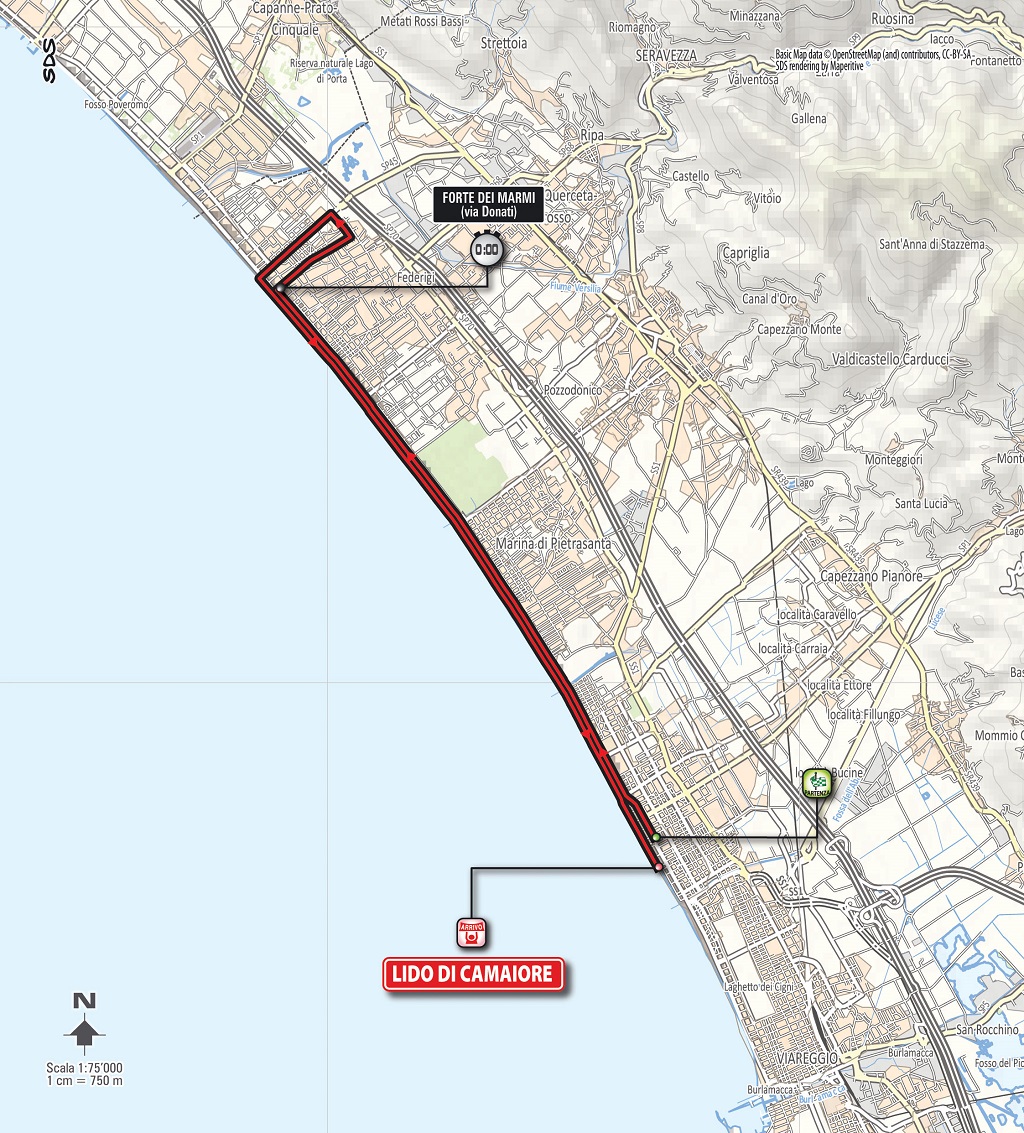
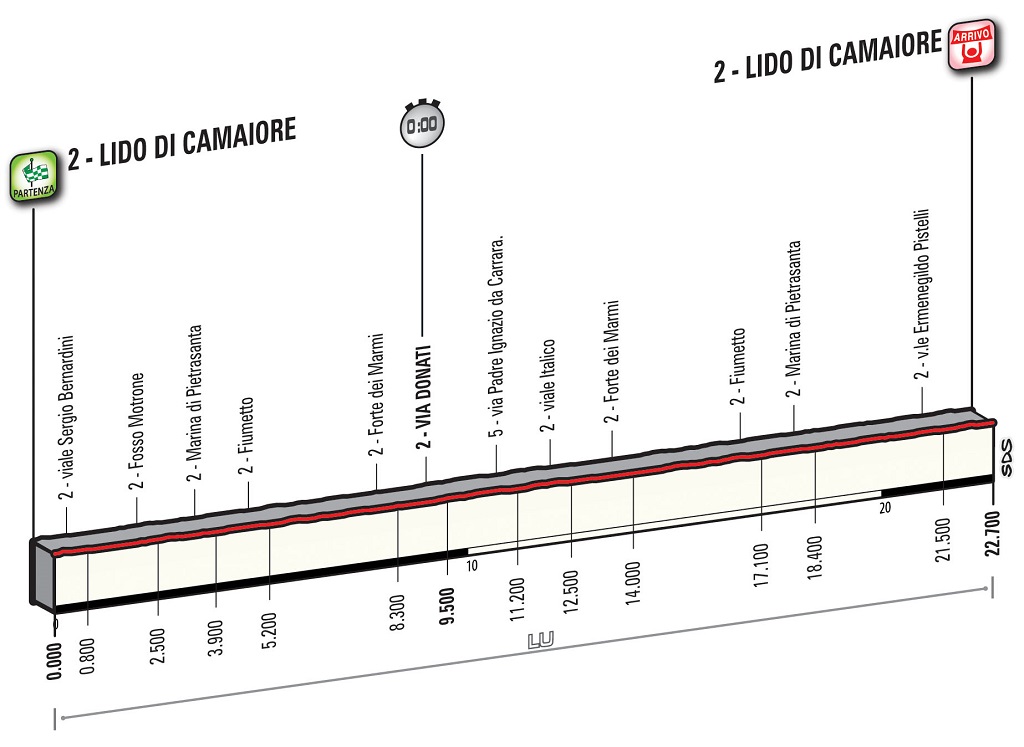
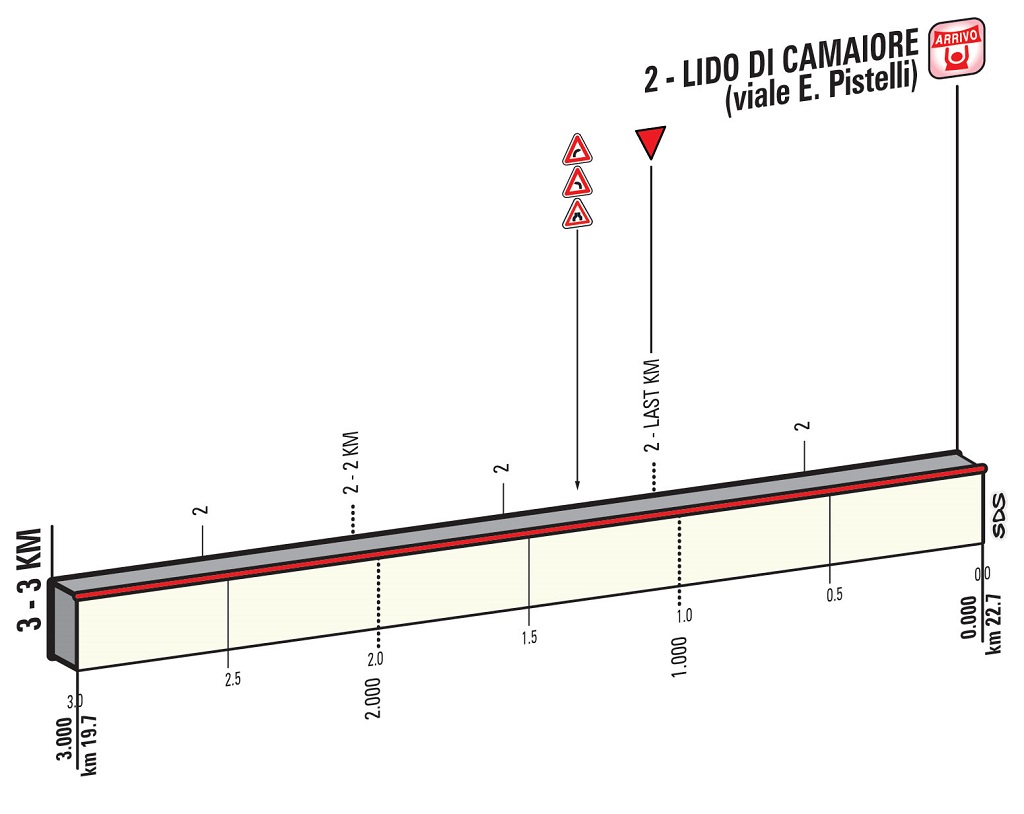
Stage 2:
The first road stage of the race has traditionally been for the sprinters but that is set to change in 2016. Instead, the riders will face the first climbing and even though it is not a day for the GC riders to make a difference, they will have to be on their toes in the uphill finale. A relatively gentle climb in the end will take out the sprinters and make it a day for classics riders. The stage is wavy and undulating, especially in the second part, and it features a summit finish that might make it suitable for puncheurs.
After the start in Camaiore on the coast, the 207km route reaches the seafront at the Lido, and then heads south towards Viareggio and Pisa, on flat roads. Gentle climbs begin while approaching Collesalvetti. The route becomes technically demanding after the feed zone, located between San Martino and Casino di Terra, where the riders have changed direction as they are now approaching the hilly interior and have left the sea behind them
After having tackled the small Canneto climb, the first categorized climb of the Race of the Two Seas will be located just past Monterotondo Marittimo (7.3km, 5.8%, max. 9%). The first intermediate sprint is located 2.4km from the top which comes after 149.6km of racing. From there, they will head to the second intermediate sprint at the 161km mark along undulating roads and then they will descend to the finish in Pomerance.
After reaching Pomarance the first time with 31km to go (the riders won’t cross the finish line), the route almost draws a circuit leading to Saline di Volterra and to the final climb (6.5km, 4.2%, max. 18%) along descending and flat roads. Just past Saline di Volterra, the route starts to go up towards Cerreto, on a long and very uneven climb, with slopes beyond 10-12% alternating with mild 2-3% gradients. After an almost flat section of 1.9%, there is one last steep stretch (15%) 3km from the finish where it averages 7.1% for one kilometre. The KOM sprint comes 2.85km from the line. The route takes a wide half-circle around Pomarance along rolling roads that are mostly descending, leading to the sharply uphill home straight (250m after the last mild bend), on 7-m wide, asphalt road. The final 100m average 7.8%. After the top of the climb, it is very technical as there are numerous turns until the riders get to the flamme rouge. Here a sharp turn is followed by three sweeping bends.
The final climb includes some very steep sections but also has several parts that are almost flat. It will create a first selection but it is definitely not hard enough for the GC riders to make a move. Instead, Peter Sagan, Greg Van Avermaet, Zdenek Stybar and Fabian Cancellara will have their eyes on a stage win and their teams are likely to control things firmly, making sure that the early breakaway is brought back. The uneven climb will make it hard for anyone to escape and the race will probably come down to a sprint from a reduced group. In the technical finale, positioning will be key and splits could very well occur and so the GC riders have to be attentive while the classics specialists will battle it out on the short ramp to the finish.
Pomerance has not hosted a stage finish for more than a decade.
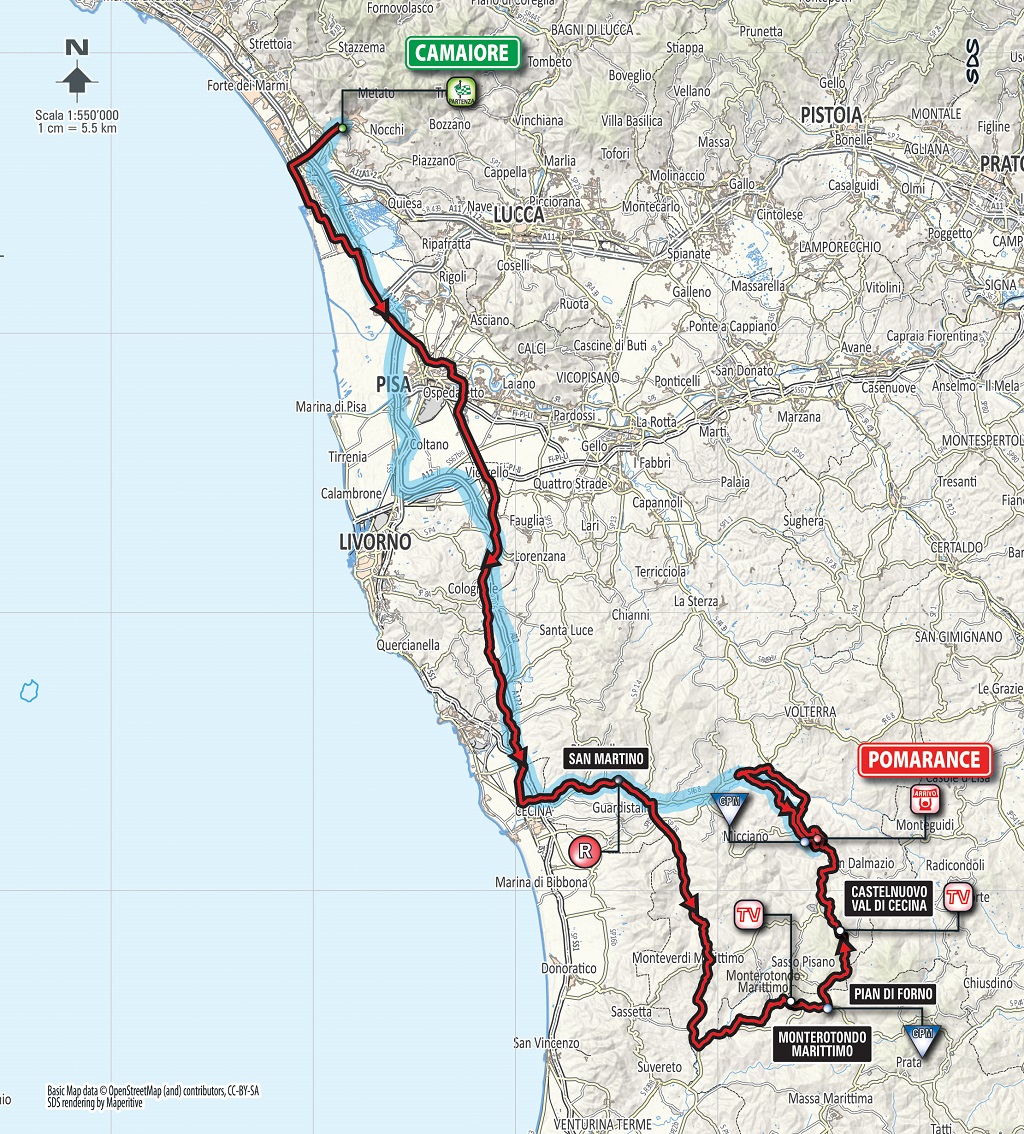
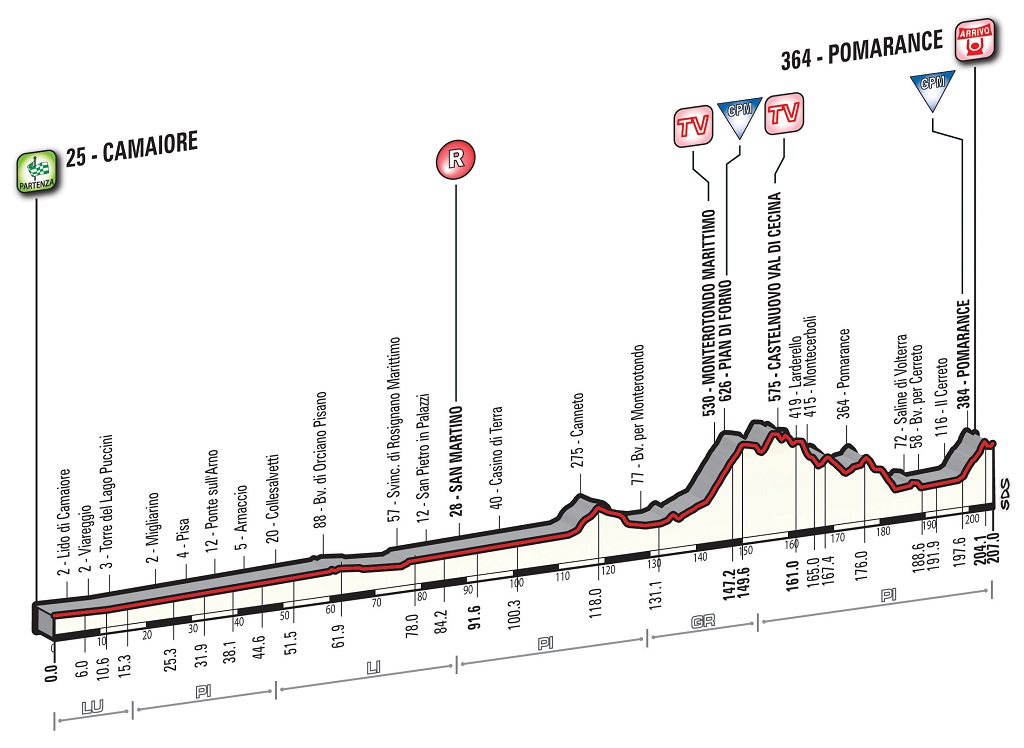
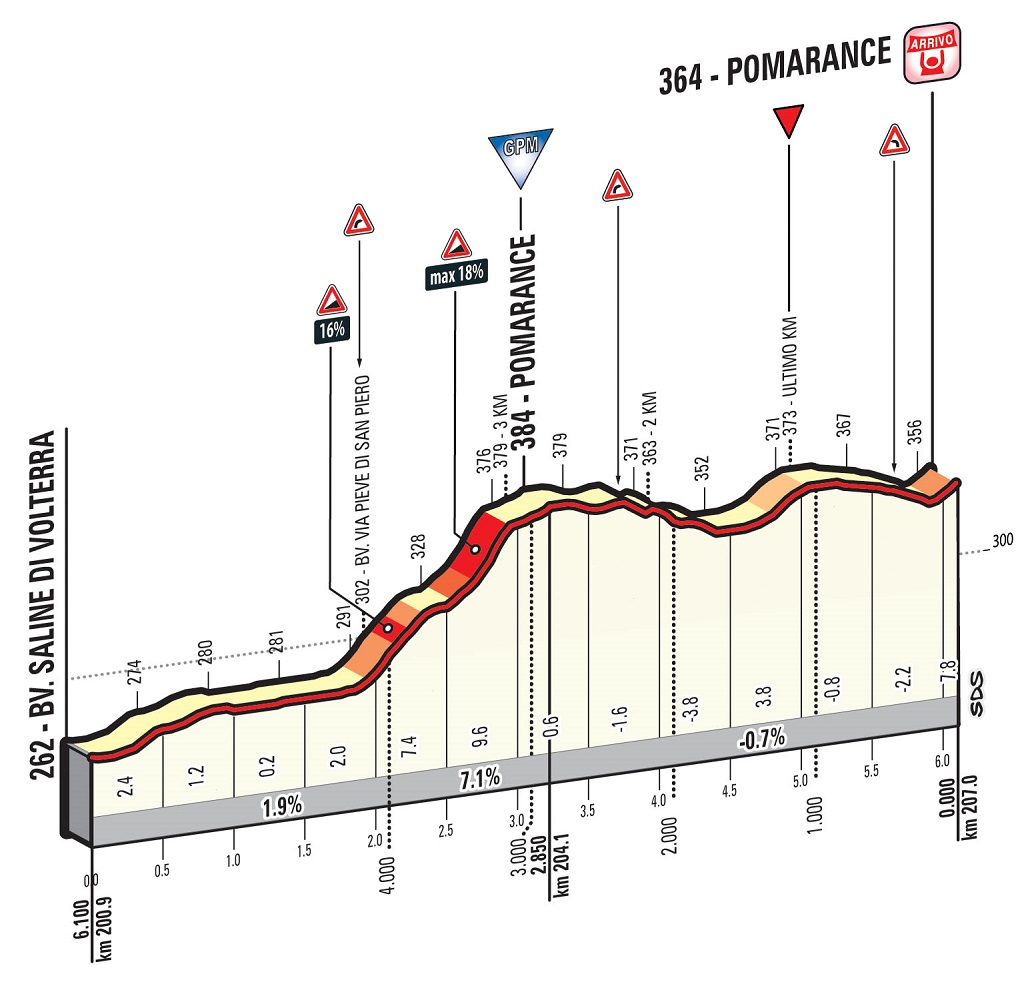
Stage 3:
For once, there was no room for the sprinters on the first road stage but they should get the chance to test their legs for Milan-Sanremo on the third day. However, the organizers never make things too easy for the fast guys and have included some climbing along the way and a tough little uphill section in the final kilometre.
The 176km starts in Castelnuovo Val di Cecina and brings the riders to Montalto di Castro. It’s a long run down the Tyrrhenian coasybut the riders won’t spend the day riding along the seafront. Instead, they will stay in the interior of the country as they head in a southeasterly direction and so the terrain is pretty hilly. The route follows the constant undulations that lead through the geothermal area, across Sasso Pisano, Monterotondo Marittimo and Massa Marittima where the first intermediate sprint is locayed after 34.2km of race. Here the road will flatten out and the route heads south, towards the Maremma, reaching Grosseto where the second sprint is located after 84.6km of racing. Then it is time for the only categorized climb to Scansano (16.7km, 3.0%, max. 8%) which is followed by a long descent and another climb to Manciano. A very long easy section follows, descending slightly all the way to the finish line in Montalto di Castro.
The final part of route first runs slightlydownhill, followed by a short climb (with 3-4% gradients) with 750m to go, leading to the heart of the city. The home straight starts here after the riders have followed a long, slightly winding road for several kilometres. It features just a mild bend with 350m to go and still runs slightly uphill (with gradients of 2-3%) on asphalt road.
As usual, the sprinters have two real opportunities in Tirreno-Adriatico and this is one of them. Of course they have to grab it with both hands and as everybody will be eager to test their condition for Milan-Sanremo, there is no chance that this won’t be decided by the fast guys. The wind rarely plays a role in this area but in the last few years the Tirreno sprints have been marred by crashes. A less dangerous finish will make things less risky but the fast guys still have to handle the short little rise in the finale. It will do very little to challenge them though but will of course give the punchy classics specialists a better chance to beat the pure sprinters.
Montalto di Castro has not hosted a stage finish for more than a decade.
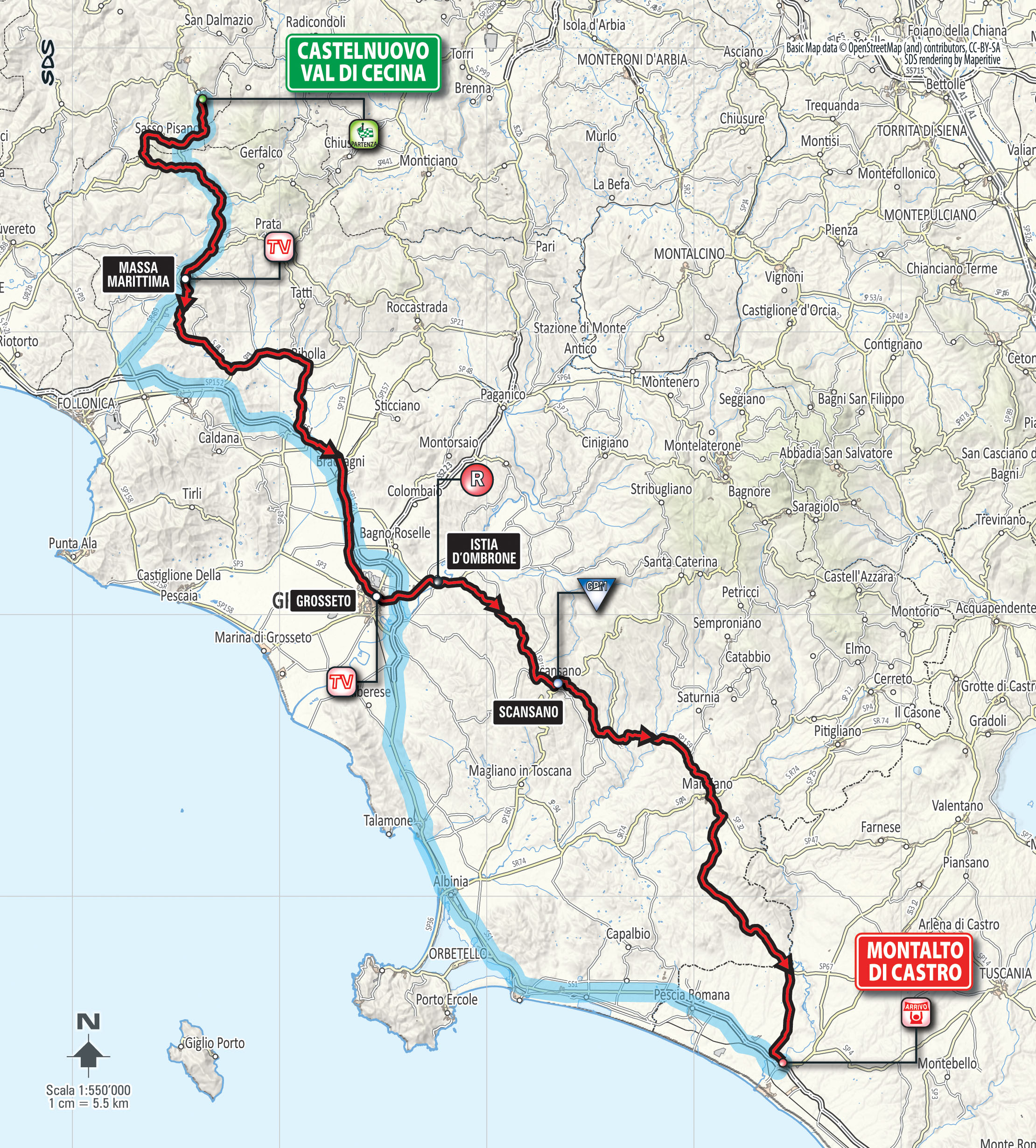
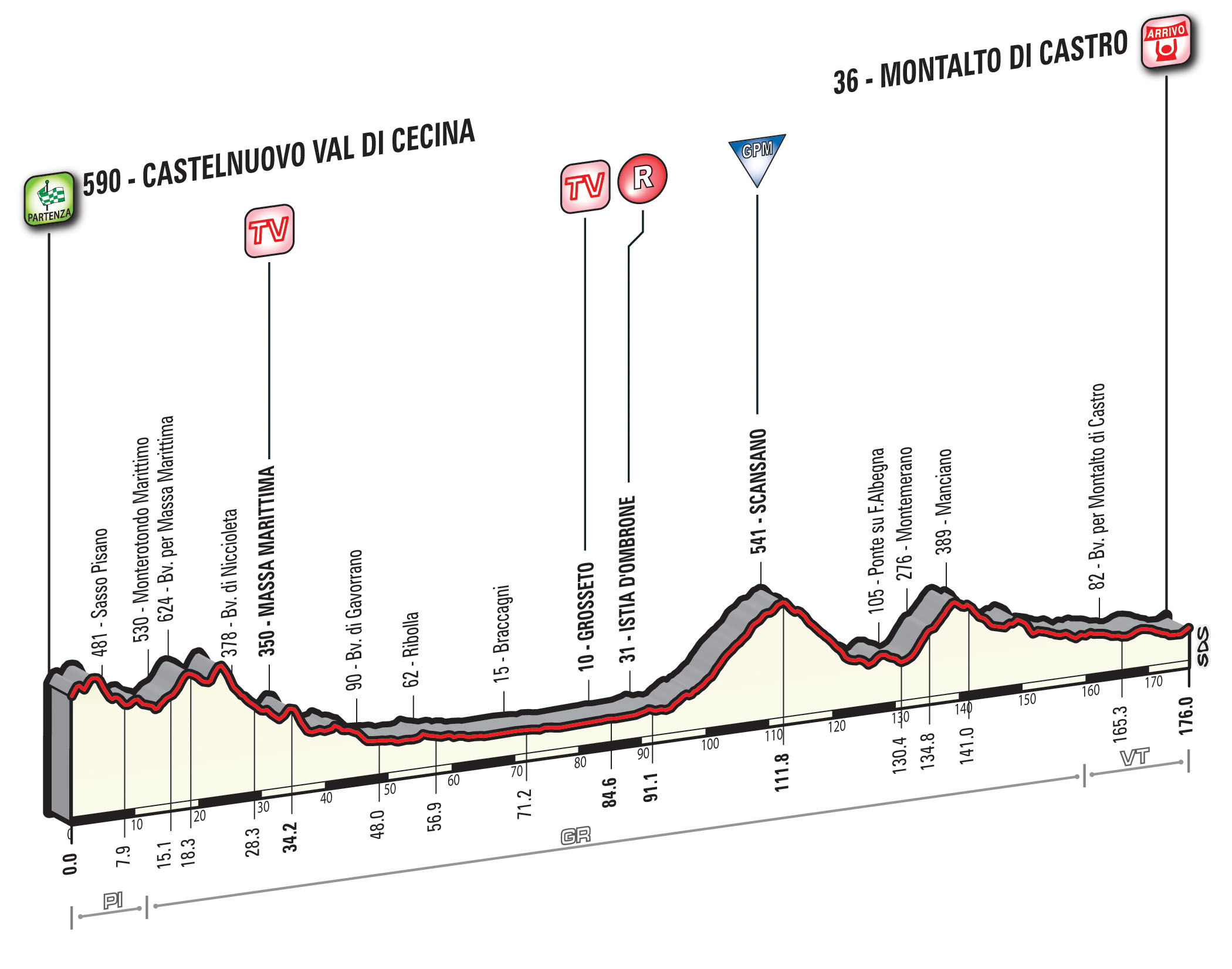
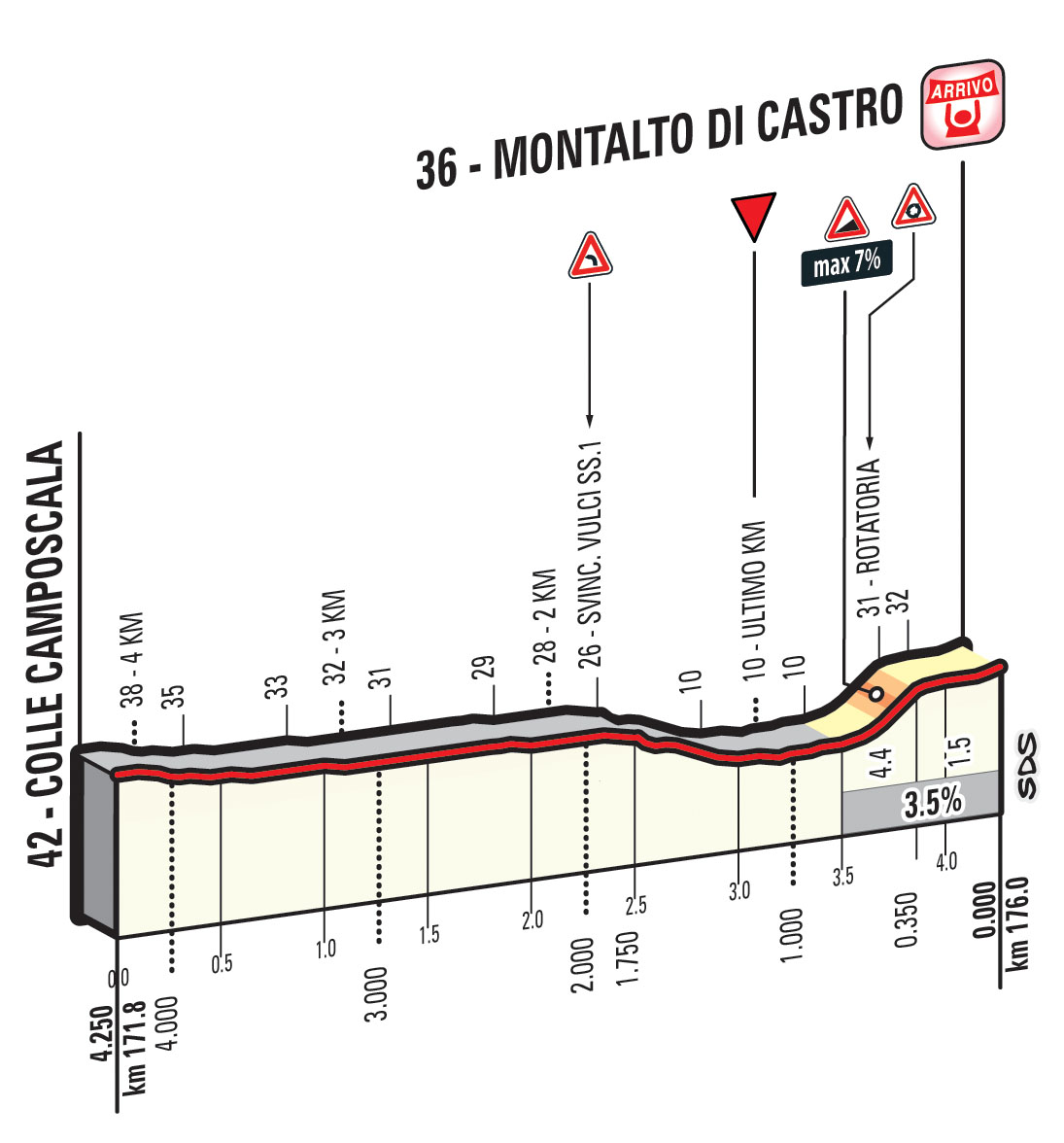
Stage 4:
In the last few years, the GC riders have had two chances to make a difference on the climbs but this year there is only one real opportunity. The fourth stage has often been a day that could create gaps between some of the best riders but that is unlikely to happen in 2016 as the course for the midpoint stage is significantly easier than it has been in the last few years. Nonetheless, it includes some significant climbing over a very long distance, making it another perfect test for the many classics riders that are gathered in Italy.
This is the first stage of the 2016 Tirreno-Adriatico featuring remarkably harsh climbs. Measuring 222 km in length, it is also the longest one that brings the riders from Montalto di Castro close to the Tyrrhenian coast to Foligno. After three days spent travelling along the coast, it is time to start the journey to the Adriatic Sea. Hence, the riders will head straight into the interior of the country, travelling in a northeasterly direction for most of the day until they turn north to approach the finishing city in the hillier final part.
The route leads through the province of Viterbo, hitting the provincial capital, as well as Tuscania and Bagnaia. After a flat stat, the road gets a bit lumpier, most notably at the uphill intermediate sprint after 76.7km of racing but there are no significant climbs in the first half of the race until the riders get to the second intermediate sprint at the 114.4km mark.
The stage finale is marked by a series of ascents and descents. After the Giove climb at the first intermediate sprint, the route reaches Amelia and Acquasparta, and then it tackles the Valico di Colle Cerquiglie categorized climb (6.7km, 4.9%, max.8%) whose summit is located at the 130.7km mark. Then a long descending secion leads to the finishing circuit which the riders hit just before they get to the main climb of Montefalco.
The long, wide, final circuit (46.6km) features a steep climb up Montefalco (5.5km, 4.1%, max. 18%, long stretches with gradients of over 12%), followed by a passage close to the finish line, another categorized climb in Trevi (4.0km, 5.3%, max. 16%) and then one final passage of Montefalco with 14.9km to go. The climbs are separated by long, flat sections. The route then drops down into Foligno, heading for the finish line along flat roads.
The last kilometres are quite uncomplicated, up to 2,000 metres to the finish. Here, a left-hand bend immediately followed by two right-hand bends just before the flamme rougelead to the home stretch, with just a mild bend with 500 m left to go. Then there’s another sweeping turn that leads to the finish line which lies on a 160-m long and 7-m wide asphalt straight road.
The roadbook doesn’t offer much information about the climbs in Trevi and Montefalco but their average gradients are not frightening. However, they include some very steep sections and knowing the terrain in this part of the country, they are likely to be much tougher than they look on paper. Some of the good climbers that are not among the big favourites may test themselves on the final climb like Wout Poels did in the similar stage last year. However, there’s a long, flat section from the top of the final climb which means that it will be much harder to stay away. With the likes of Peter Sagan, Edvald Boasson Hagen and Greg Van Avermaet targeting a stage win, this should be decided in a reduced bunch sprint.
Foligno last hosted a stage in 2003 when Mario Cipollini won a much easier stage in a bunch sprint. The sprinters also came to the fore in the 2014 Giro d’Italia where Nacer Bouhanni came out on top in another bunch kick.
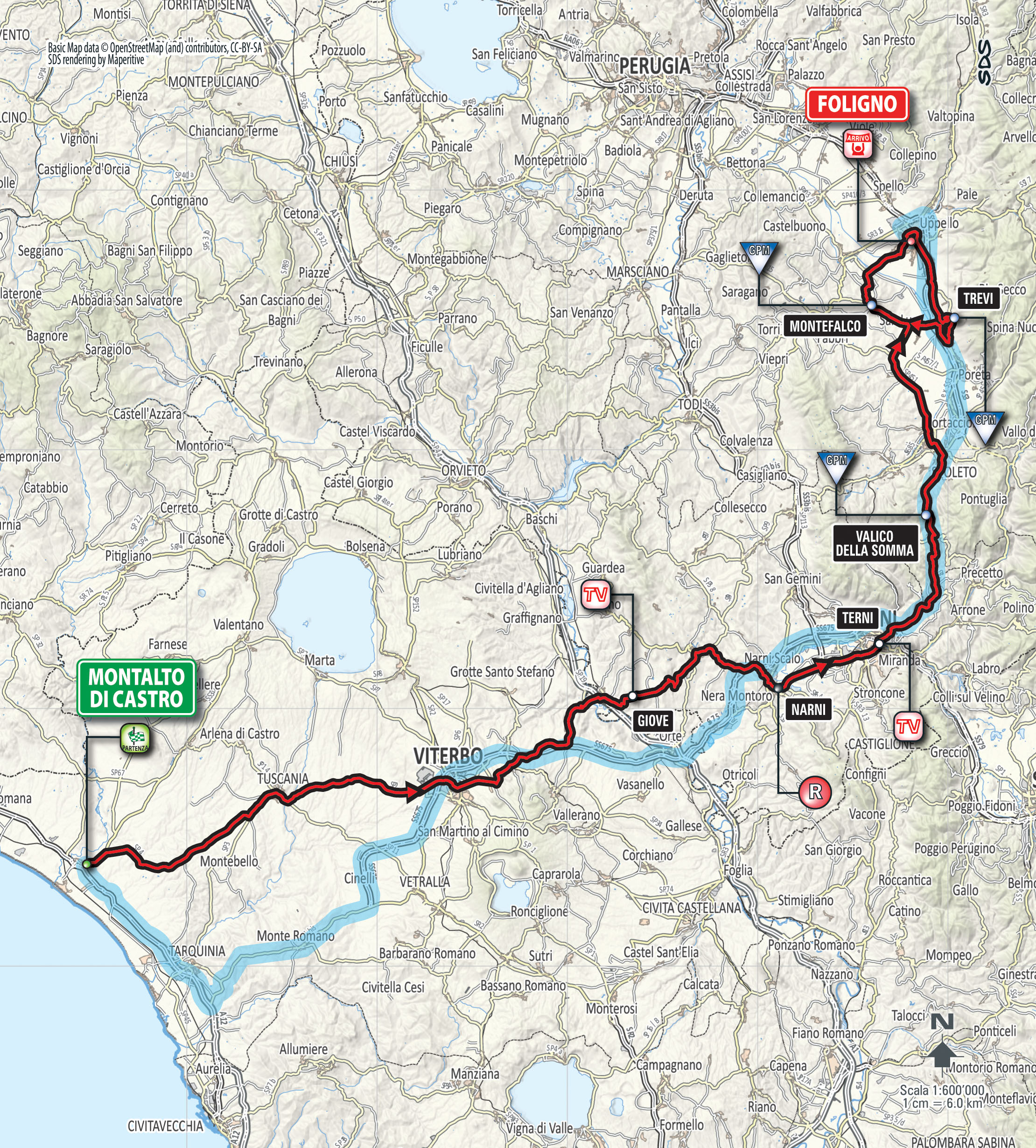
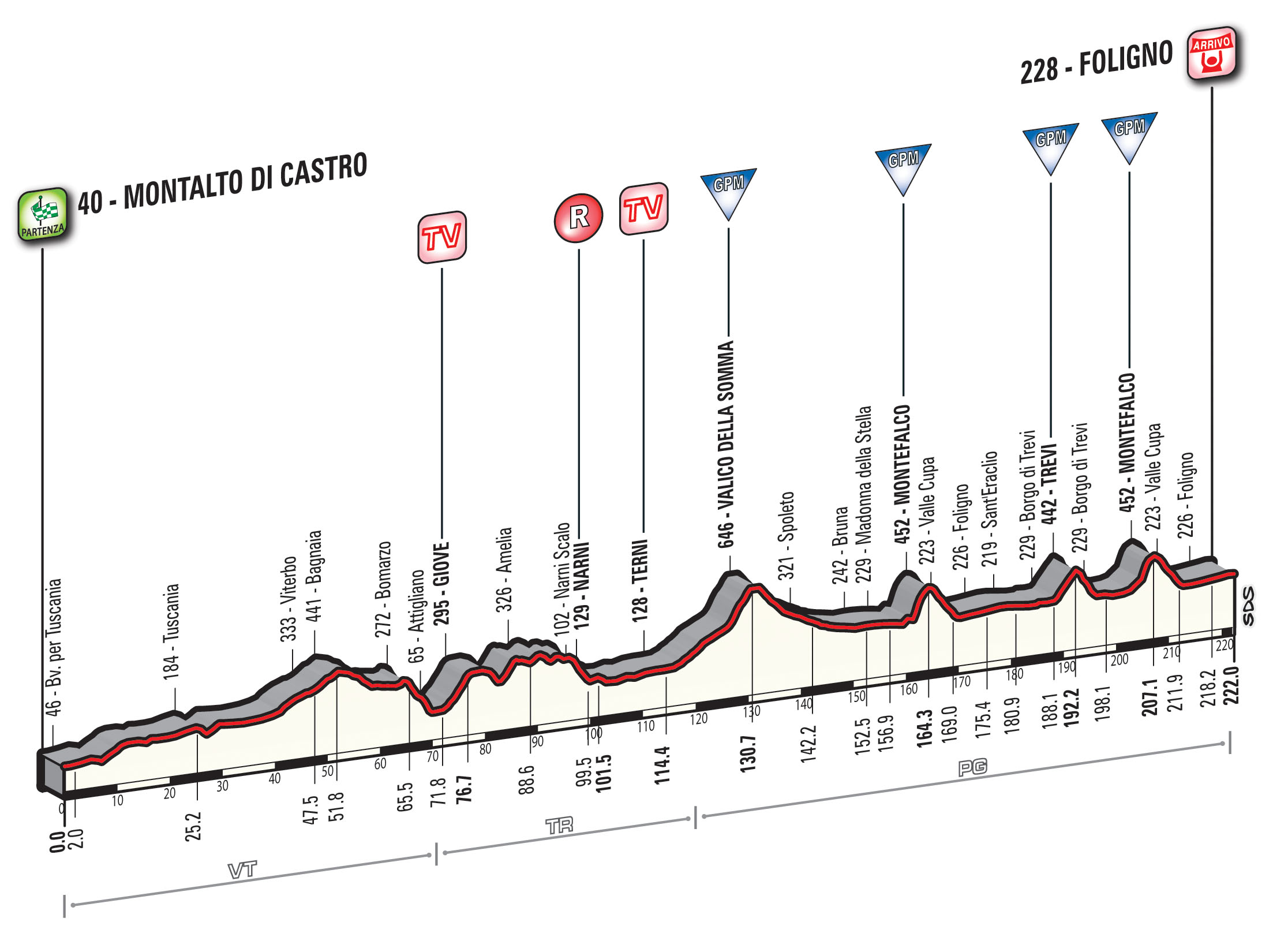
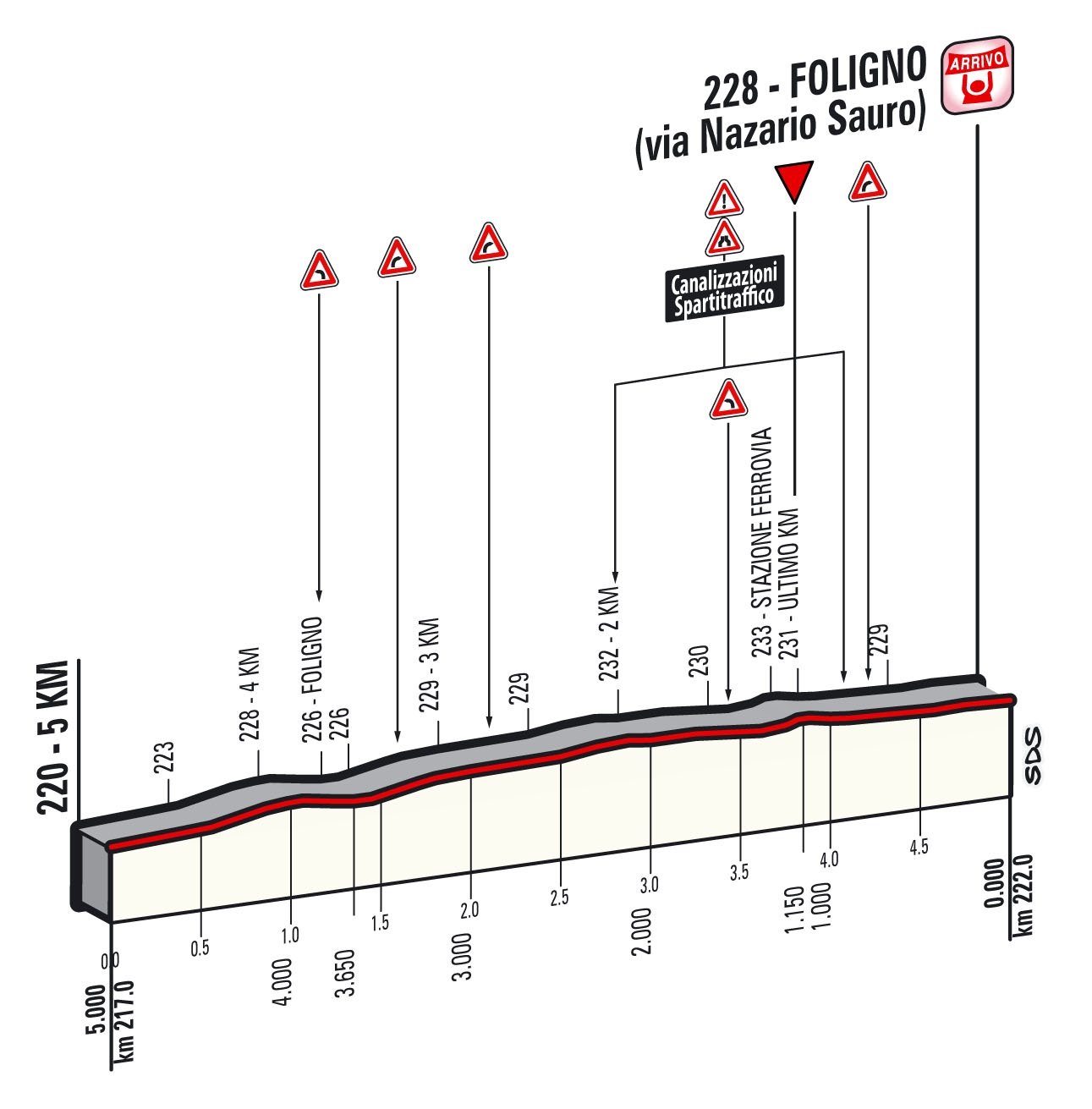
Stage 5:
Tirreno-Adriatico was once a race for classics riders but since 2012 the race has headed into the real mountains on the fifth stage where it has included a big mountaintop finish. It is always risky business at this time of the year – just recall how Nairo Quintana had to battle snowy conditions on Monte Terminillo last year – but the organizers have stuck to the idea. In 2016, the climbers only have one chance to make a difference and it comes in a very tough stage 5 that finishes at the top of the new climb of Monte San Vicino. As it is preceded by numerous big climbs, the queen stage of the race looks hader than it has been for some years.
This is the mountain stage of the 2016 Tirreno-Adriatico, featuring what the organizers call “Superior” summit finish. Despite measuring less than 200km in length – the distance is 176km – it is still a queen stage across the Apennines and brings the riders from Foligno to Monte San Vicino. It sees the riders zigzag their way through the hilly terrain as they first head to the southeast and then start a long northerly run in the second part of the race.
The route starts uphill, heading towards Valico del Soglio (27.1km, 2.2%, max. 9%) along slightly ascending roads where the first KOM sprint comes at the 28.6km mark. A descent and an easier section leads to the first intermediate sprint at the 64.4km mark and then the hostilities will start.The riders will tackle the Frontignano (5.9km, 8.4%, max. 12%), Arette (5.9km, 7.1%, max. 12%) and Montelago (5.5km, 7.0%, max.11%) in rapid-fire succession, with not even one actual flat kilometre in between. Only the latter two climbs are separated by a longer descent which will give some room for recovery.
After the descent, the final part, just past Pioraco, features two short, yet sharp climbs in Brondoleto and Castel Santa Maria (punchy bits with gradients peaking 12-13%). A stretch on narrowed roadway leads to Matelica, just before the route takes in the final, 13.1-km climb, with a 6.6% gradient and peaks reaching as high as 12%.
The final 10km average 7.8%. The gradient stays around 7-8% for most of the time, with the steepest 12% section coming six kilometres from the finish. There are a few easier sections but there won’t be much room for recovery.
The last kilometres of the stage correspond to the final Monte San Vicino climb, which can be divided into two constantly-sloping parts: the first one, with a gradient of around 7%, stretches until 2 km from the summit and includes an 11% section 3km from the finish, while the second one is slightly milder and leads all the way up to the finish. The gradient is around 5-6% between the 2.5km and 1.5km to go marks and then the next 500m average 8.8%. In the final kilometre, the gradient is between 4.8% and 6.8%. There aren’t many turns on the climb but the final kilometres are more winding. The 200-m long home stretch runs slightly uphill, on 7-m wide asphalt road after a sweeping left-hand turn.
Monte San Vicino has not hosted the finish of a major bike race for more than a decade.
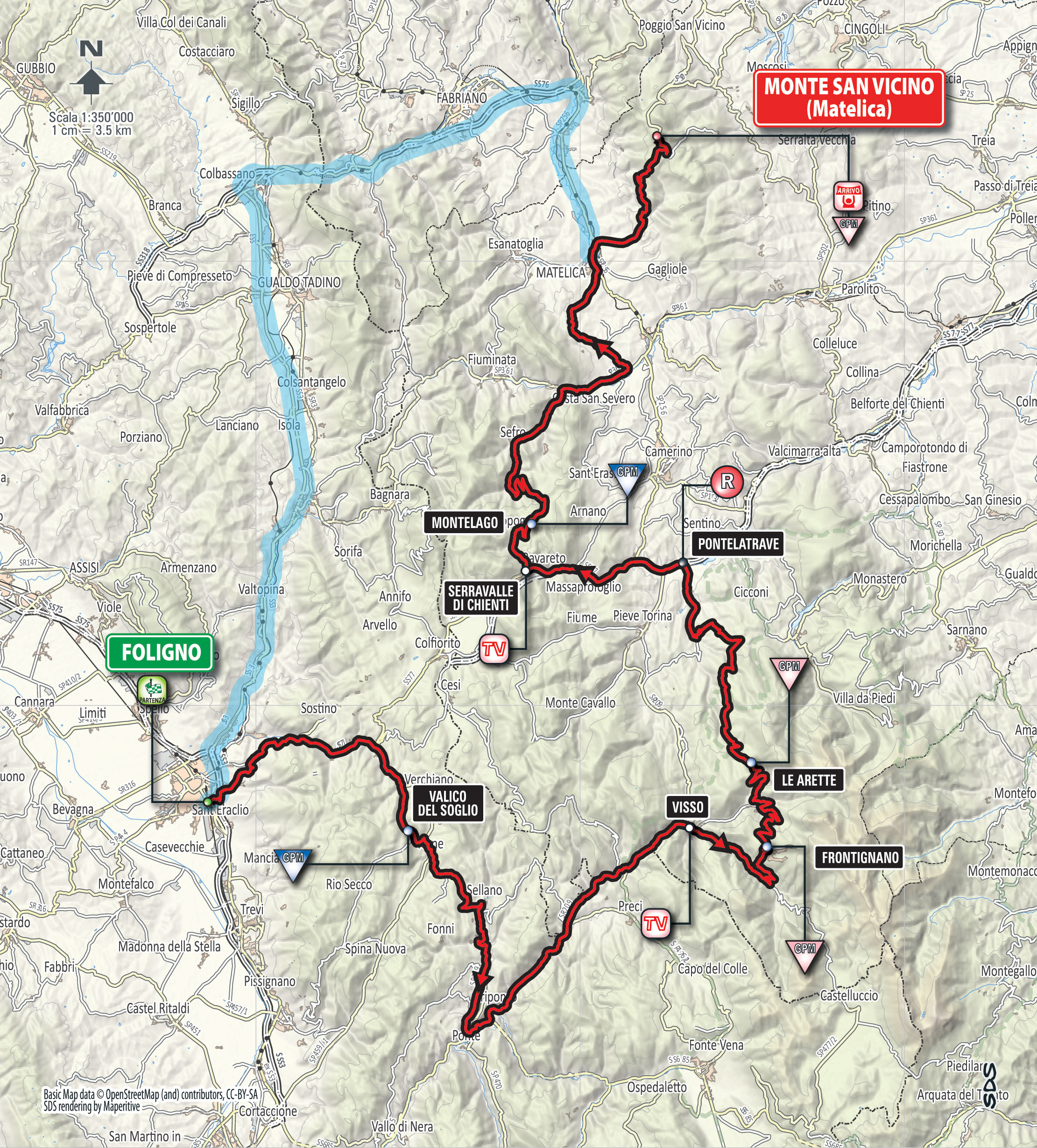
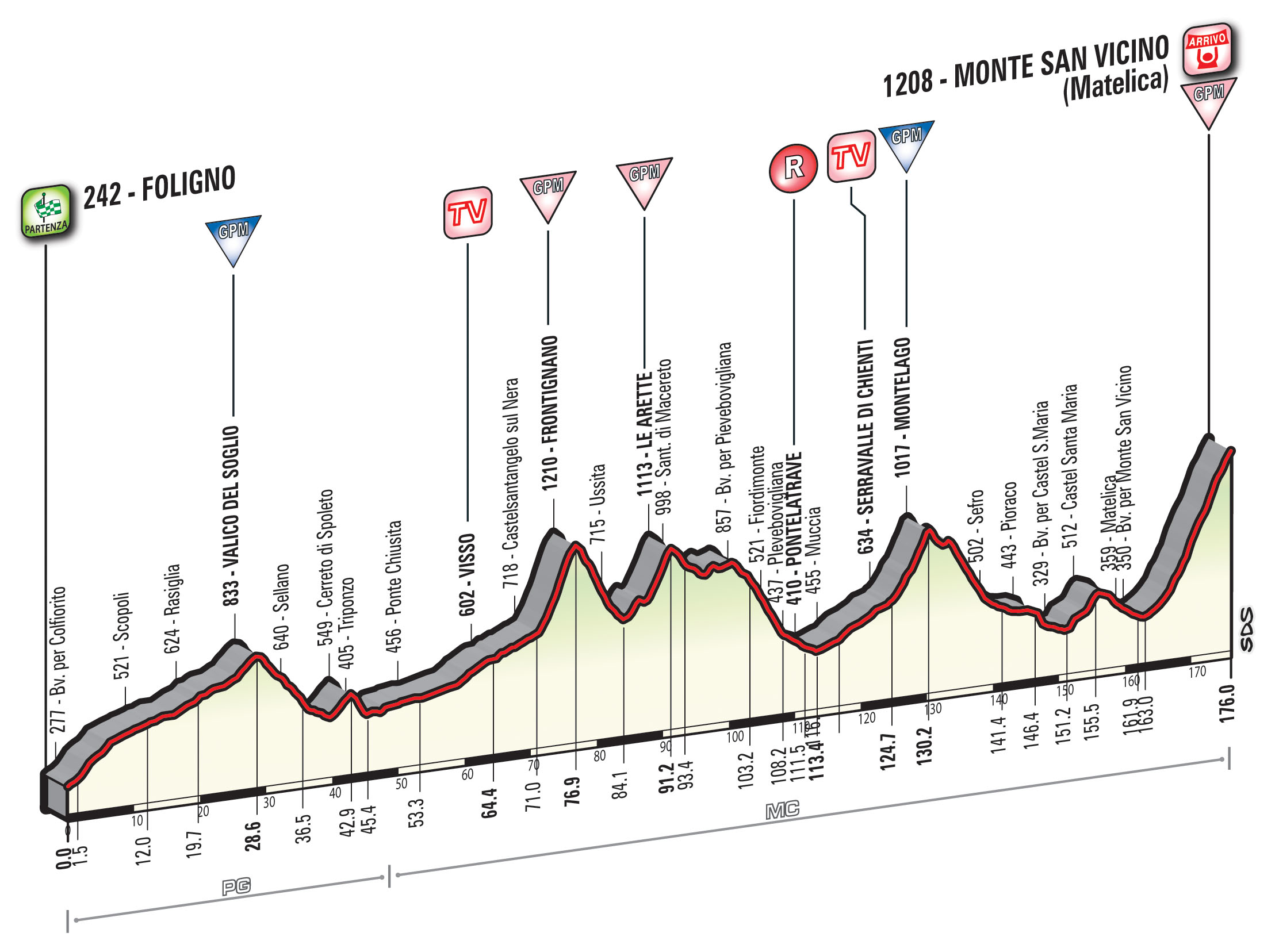
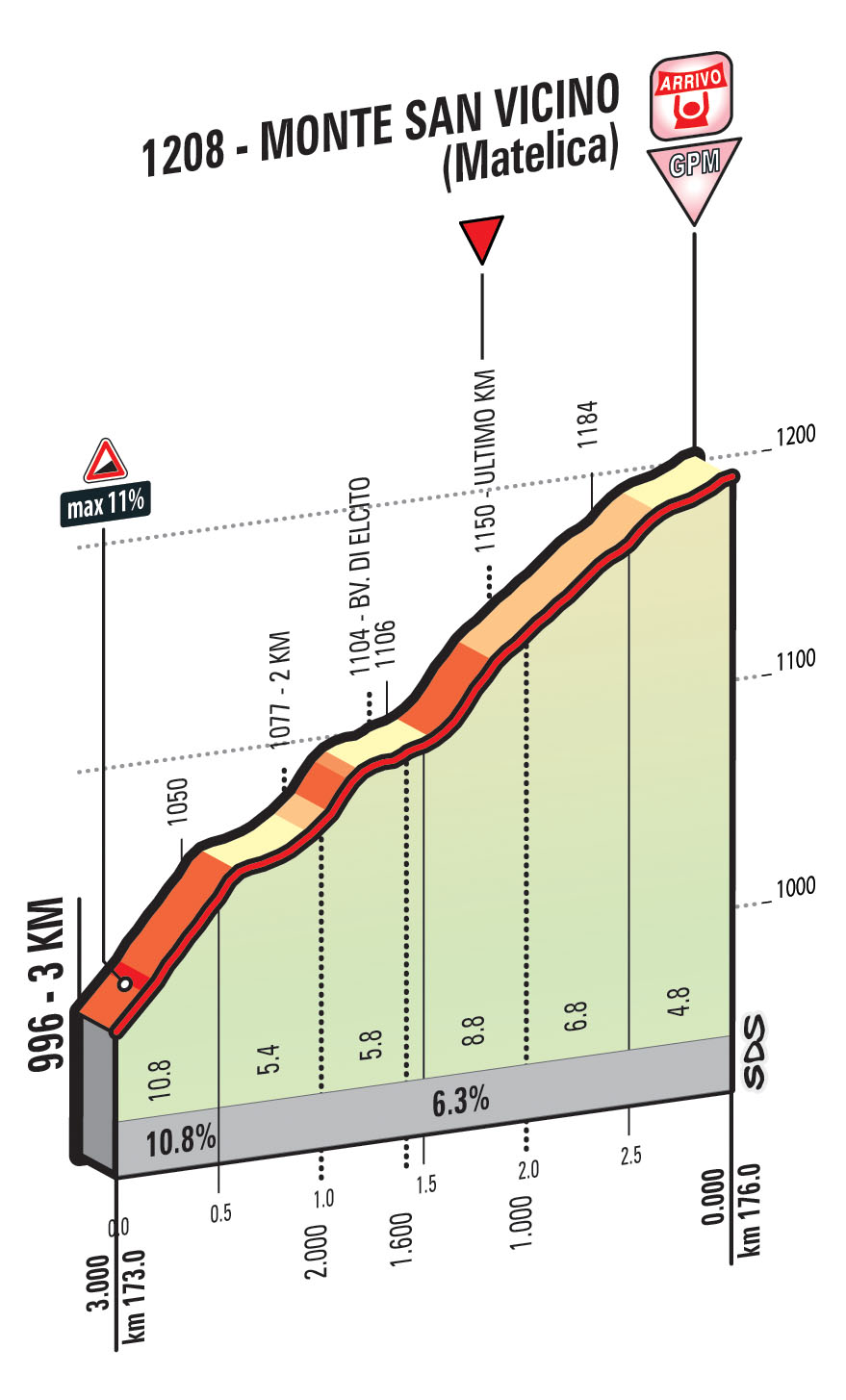
Stage 6:
After the brutally hard 2013 edition of the race, the organizers decided to give the sprinters a goal in the second half of the race by including a sprint stage on the penultimate day in 2014. Last year they repeated the formula but a late climb changed the script and led to a reduced bunch kick. This year the sprinters don’t have to handle such difficulties as everything suggests that they should get a chance to test their speed less than a week before Milan-Sanremo.
At 210km, it is another very long stage – perfect to prepare for Milan-Sanremo. It brings the riders from Castelraimondo to Capagatti. The stage runs basically flat all the way to the finish, where a final circuit will be covered twice. The peloton has almost completed the journey to the Adriatic coast and the first part will bring them to the seafront. The route leaves Castelraimondo, leads through San Severino Marche and Passo di Treia to tackle the only KOM climb of the day (3.4km, 5.5%, max. 10%, the last one of the whole race) in Pollenza after 27.5km of racing. After the descent, the route levels out and rolls along the coast up to Montesilvano along completely flat roads. There’s an intermediate sprint at the 137.km mark. From here and following a few short, gentle undulations, it leaves the coast just before Pescara to head for Cepagatti where two final laps will be covered. There will be an intermediate sprint at the first passage of the line.
The final 11.4km circuit has a triangular shape. The first side runs downhill, the second one is flat, while the third one runs constantly uphill (a little more sharply at the beginning where it averages 5.7% over 1km and at approx. 2-3% after that, with the final 1.5km being the steepest) up to the finish line. There are no major technical challenges as there’s a roundabout just after the 4km to go mark and from there it is an almost completely straight road. There’s a final left-hand turn 400m from the finish. The stage finale follows the historical 1990s Cepagatti circuit (with just a few minor changes).
This is by far the easiest stage of the entire race and with a formidable line-up of sprinters. They are very unlikely to miss their chance. A big part of the stage takes place along the coast but the wind rarely comes into play. This stage should be decided in a big bunch sprint but the slightly rising finale means that it could be a bit more suited to the stronger sprinters than the fastest riders.
Cepagatti has not hosted a stage of a major bike race for more than a decade.
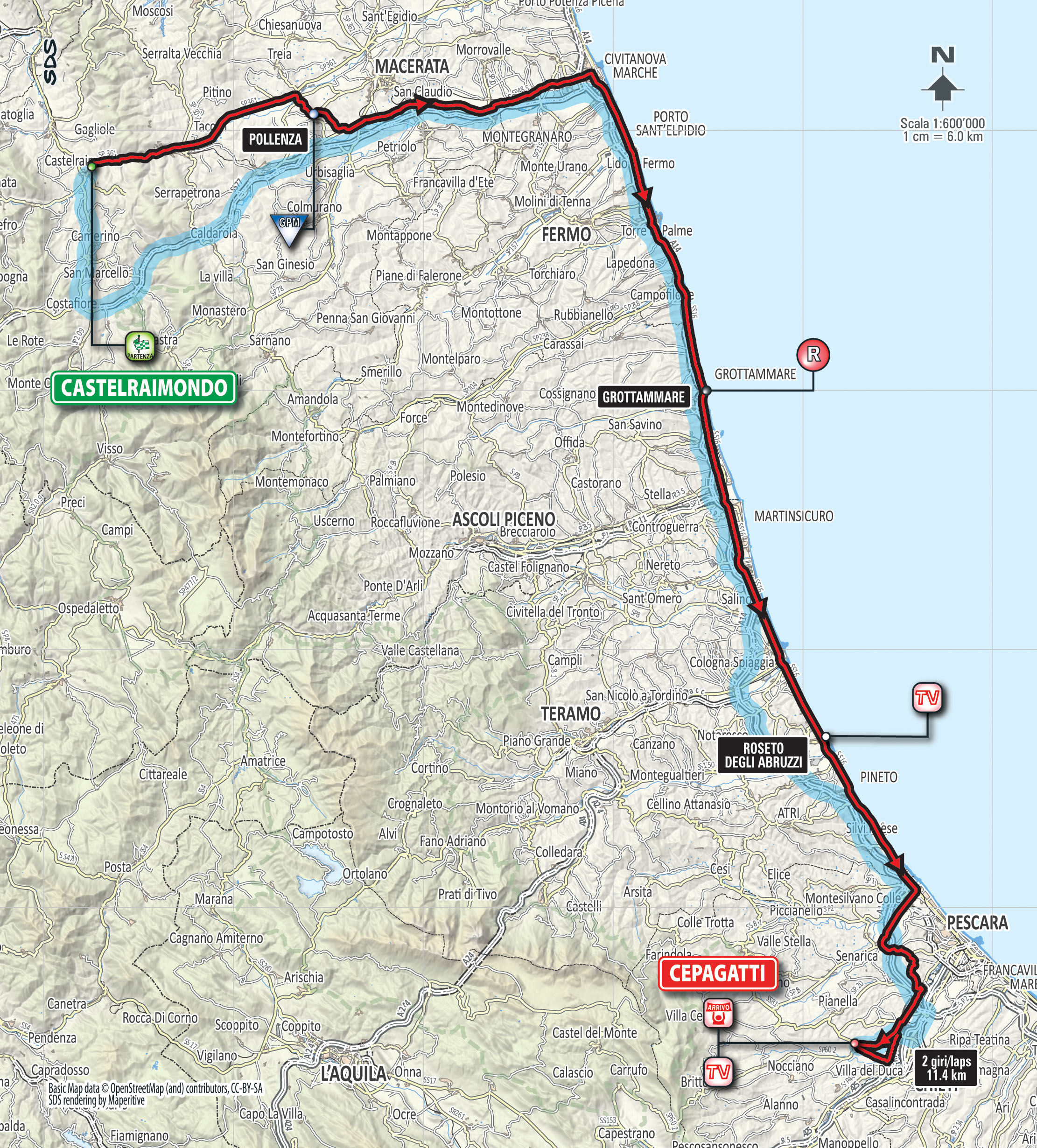
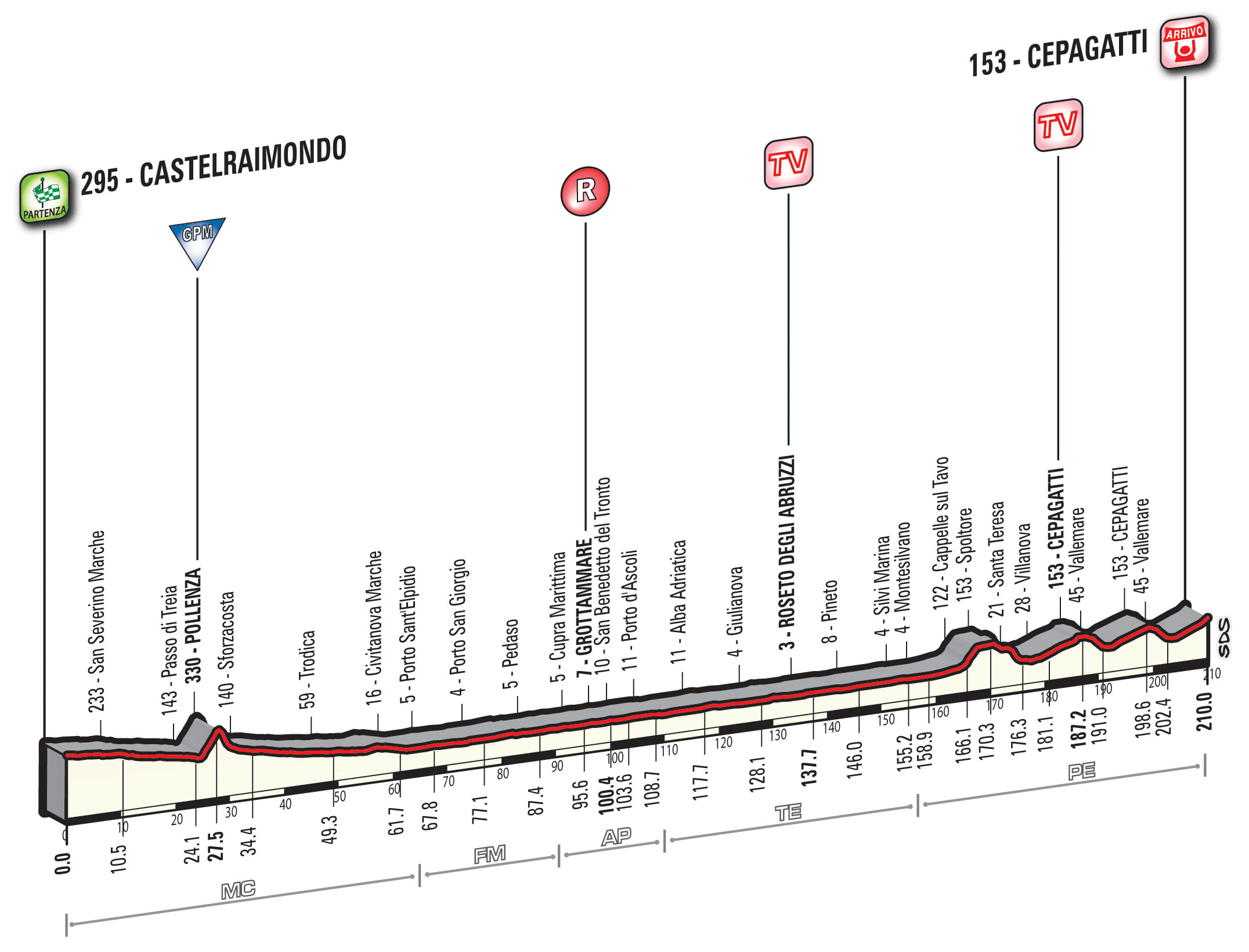
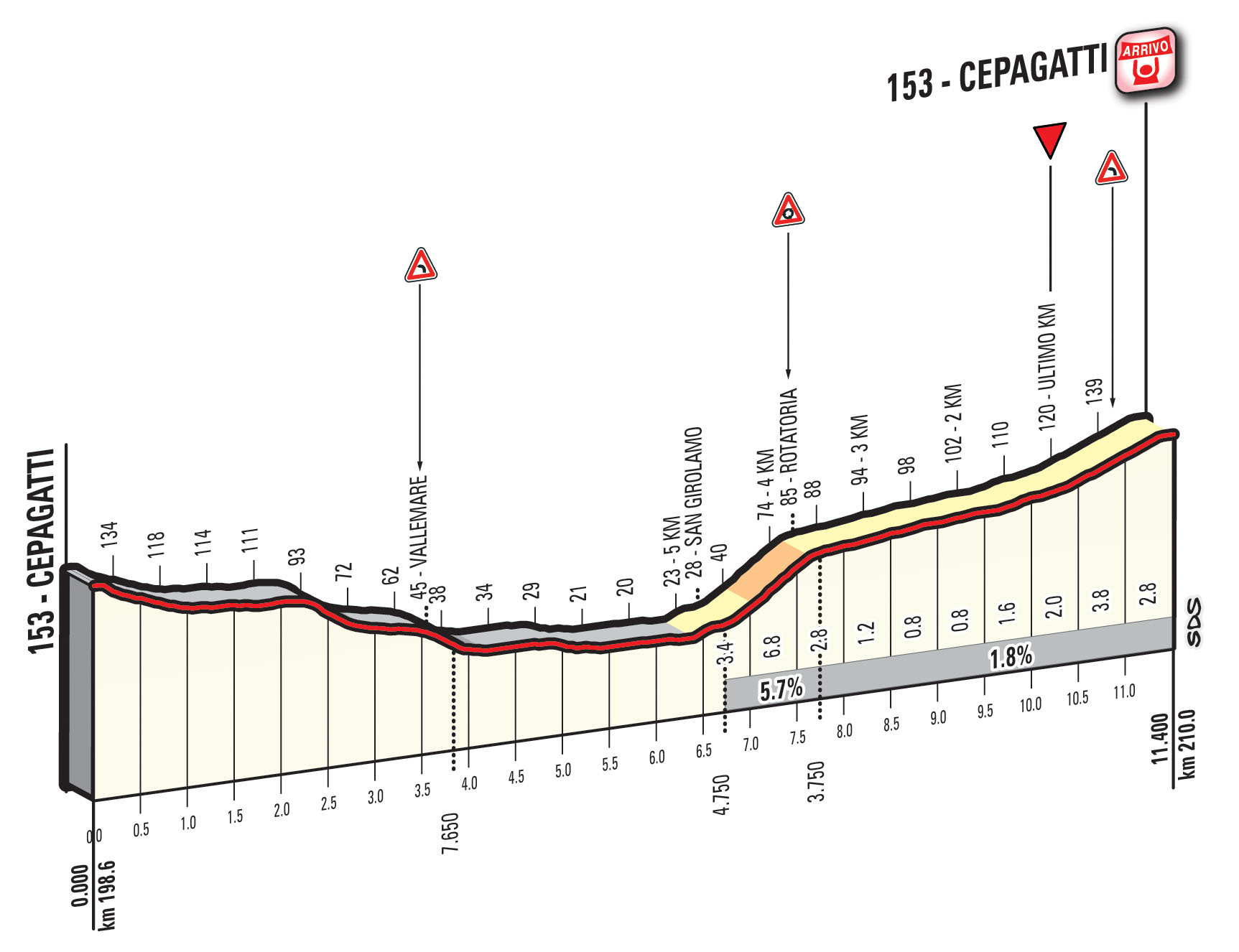
Stage 7:
In the first part of the century, Tirreno-Adriatico always ended with a flat circuit race along the coast in San Benedetto del Tronto while any time trialing often took place on hillier courses earlier in the race. That script was ended after the 2010 edition when Edvald Boasson Hagen was the last sprinter to win in the coastal city.
The five most recent editions have all ended with a virtually identical time trial on an out-and-back course along the Adriatic Sea in San Benedetto del Tronto and this will again be the case for the 2015 edition. This year's 10km stage is an exact copy of the stage that has been used for the past editions and is completely flat and very non-technical.
The riders take off from the seafront and quickly take a left-hand turn onto the coastal road. From there it is very simple all the way to the finish. The first part is a straight run down the coastal road until the turning point which comes just before the 5km to go mark. Along the way, they pass the time check which will be taken after 4.4km of racing. The riders do a U-turn and then it is straight along the coastal road all the way back to the finish, with just a very slight bend along the way. The last 3km run along wide and mainly straight roads. The route climbs along the seafront (uphill roadway) towards the finish line. 2.5 km before the finish, a double bend leads to the straight home stretch (2,500 m), on 8-m wide asphalted roadway.
Due to the short distance, the time gaps are usually rather small and in the last few editions, it hasn’t had a huge impact on the final GC. This year the mountaintop finish is harder than it has been recently and the team time trial is longer so it will have less of an impact. However, time gaps can often be small in this race and so it may still prove to be decisive in determining the overall winner.
With long, flat roads, this is a course for the true specialists who can use their big power to get up to maximum speed and keep it there for their entire ride and it is no wonder that Fabian Cancellara won the two first editions before being beaten into 4th by Tony Martin, Adriano Malori, and Andrey Amador in 2013. In 2014 Adriano Malori took what was then the biggest win of his career when he beat the giants Cancellara, Bradley Wiggins and Martin after a great performance on home soil. Last year Cancellara again came out on top in a battle with Malori who had to settle for second place.
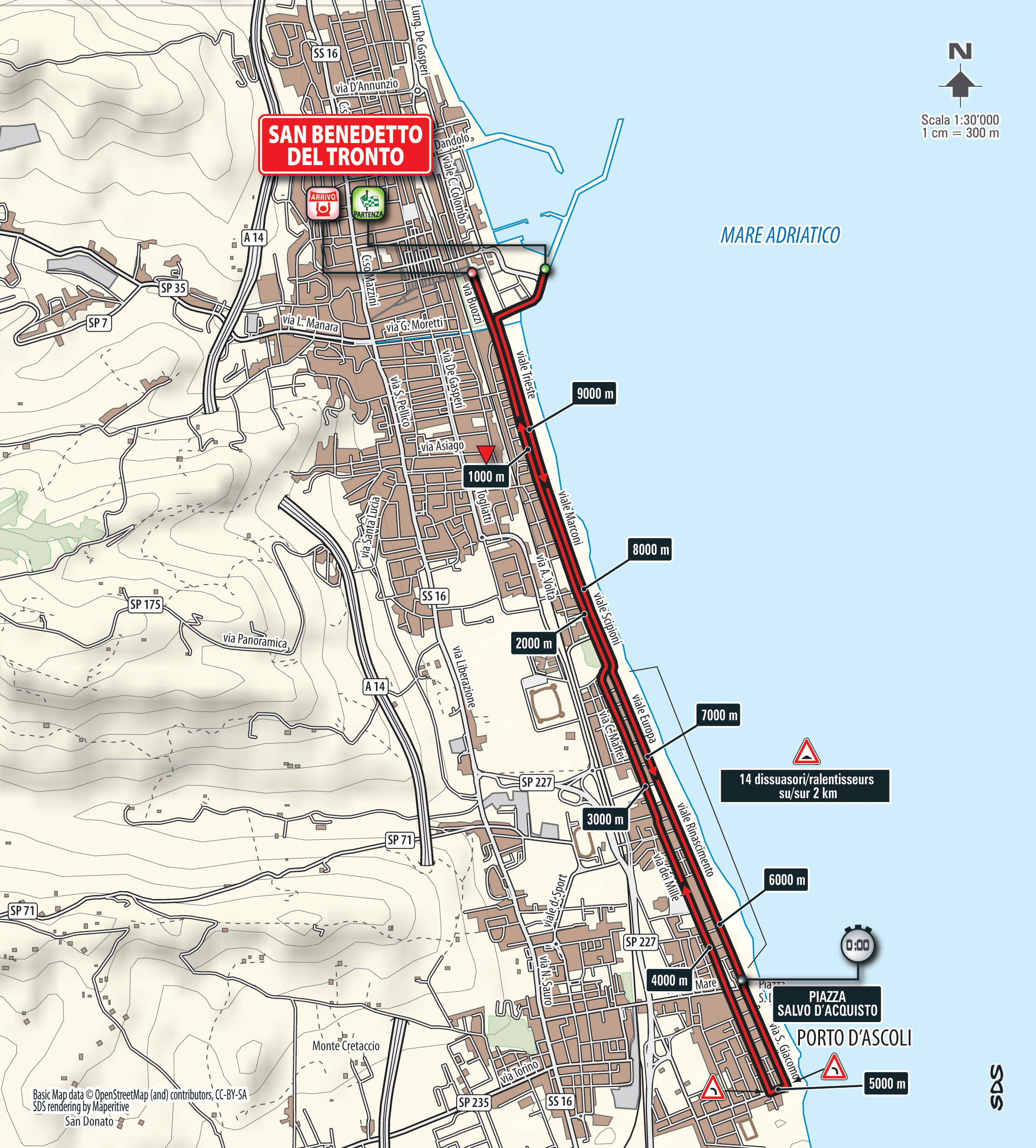
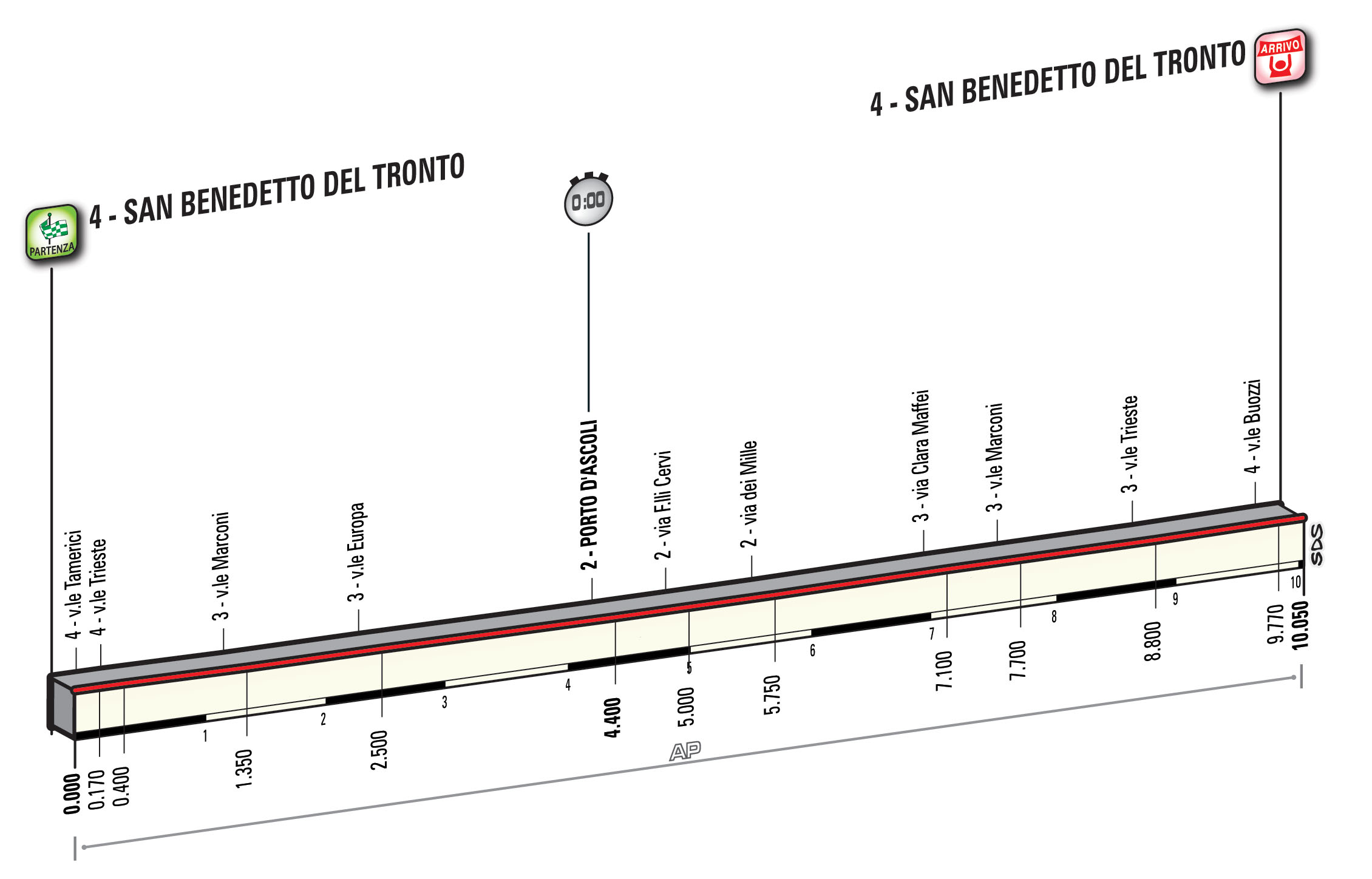
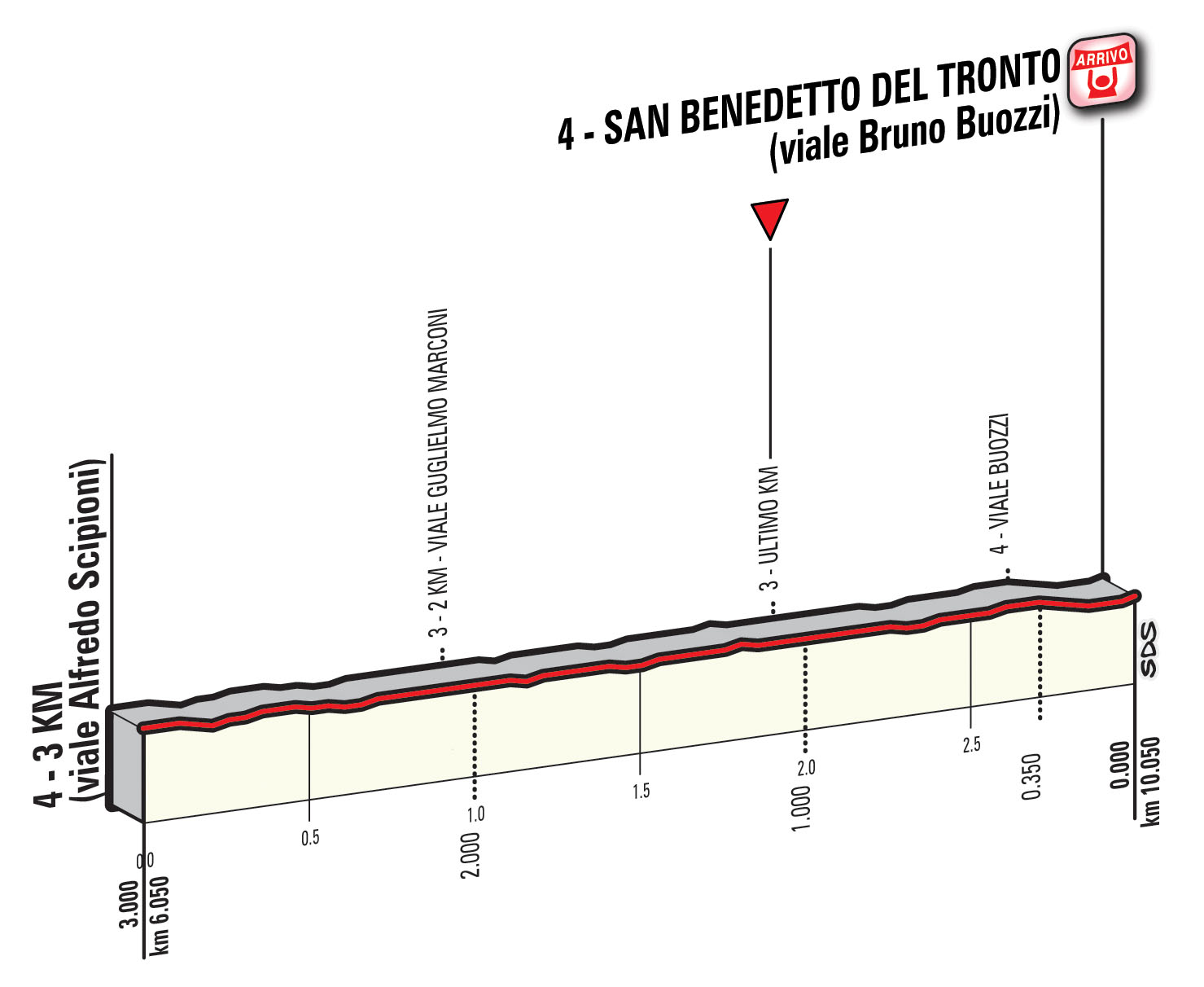
The favourites
With the current layout of the course, it is hard to imagine how this race was once suited to puncheurs and sprinters. The format of a mini grand tour means that it is now suited to the real stage racers and the race will be decided by the combination of the skills that traditionally decide the three-week races.
Like a grand tour, the race has a bit for everyone but like in the big stage races, the mountaintop finishes and individual and team time trials are usually where the time gaps are made. It will be no different for Tirreno-Adriatico. With the wind rarely playing any role in this race, it will only be important for the GC riders to avoid splits in the finales and stay safe on stages 3 and 6 which should be for the sprinters. Stage 2 has a very tricky finale but the final climb is not hard enough for the GC riders to make a difference. However, splits are likely to occur in that kind of technical finale so it will be important to be well-positioned. A fast sprint may allow some of the GC riders to pick up a few bonus seconds. Stage 4 has often been one for the GC riders to make a move but this year it is less hard so it will make no difference in the GC battle.
What will ultimately decide the race is the combination of stage 1, 5 and 7. In the past, the team time trial has often been pretty important and this year it will be even longer than it usually is. The final time trial is a well-known one and the time gaps between the best GC contenders are pretty small. However, a poor time triallist can lose some ground there.
Of course it is the mountaintop finish in stage 5 that will be most important. Monte San Vicino may not be the hardest climb in Italy but it definitely has the gradients to create a solid separation. This is the big day in the race and it is the day when the biggest gaps will be made. Overall it will mainly be the combination of climbing and team time trialling skills that will decide this race.
The race has a strong line-up and many of the riders are on pretty equal terms, making it a pretty open and unpredictable affair with several potential winners. However, four names stand out: Thibaut Pinot, Vincenzo Nibali, Alejandro Valverde and Tejay van Garderen.
Thibaut Pinot has flown a bit under the radar in the build-up to the race but he emerges as our favourite to win. The Frenchman has been flying all year since he made his debut in Marseille and this is his first big goal of the year. The course doesn’t exactly suit him as FDJ have rarely performed well in team time trials and this has often been a big setback. However, they have improved massively and did some excellent TTTs in Romandie and the Giro last year. For this race, they have a very similar team and if they can confirm their improvements, they should be able to limit their losses well. Of course they will lose time to Movistar and BMC but they could very well beat Astana.
The final time trial will also be a challenge for Pinot but he has improved his level a lot. Most recently he did really well in a short flat time trial in Algarve and there is no reason that he can’t beat the likes of Alejandro Valverde and Vincenzo Nibali in this kind of test. He will lose some time to van Garderen but it will only be a matter of a few seconds.
The big day for Pinot will of course be the queen stage. This is where he has to win the race. Until now, he has only tested himself on shorter climbs that haven’t really suited him but he has always been among the best. Now he finally faces a really long climb and as bad weather is forecasted, he will find the conditions to his liking. Last year he proved his excellent climbing skills by winning the queen stages in both Switzerland and Romandie. As we haven’t been impressed by Valverde and Nibali, we think that Pinot will be the best climber here. It will all be a question of whether he can gain back enough time. The climb is hard so we think he will succeed. It is time for Pinot to win a WorldTour stage race.
Alejandro Valverde delivered a dominant performance in the Ruta del Sol. Nonetheless, it is hard not to be left with the impression that he is not as strong as he usually is at this time of the year. That was confirmed in Strade Bianche where he has always been among the best but this year he was never really in contention. Of course he had to do a big part of the race on Ventoso’s bike and he had cramps in the finale but it just confirms the impression that we have had since the start of the year.
It’s no big surprise though. Valverde will have a very heavy season and he aims for a slower start. He has deliberately held something back. Nonetheless, he can still win this race as it suits him really well. His Movistar team will be one of the strongest in the team time trial even though they miss both Adriano Malori and Jonathan Castroviejo. That will give him a head start over most of his main rivals. He can pick up bonus seconds in stages 2 and 4 if he goes for the sprints and he should be able to defend himself reasonable in the final time trial as he is usually a good prologue rider – even though this one is too flat for him.
The main question is whether he will be able to follow the best on stage 5. Based on his performance in Ruta del Sol he will but the level here is a lot higher. His condition is not at its best yet but his time gains from the team time trial and bonus seconds could still be enough to win the race.
Only one rider in the field has won the race recently. Vincenzo Nibali came out on top in both 2012 and 2013 but has had disastrous starts to the past two seasons. This year he is finally back to his best and he has already won the Tour of Oman. That has set him up nicely for this race which is his first real goal of the year.
However, the race in Oman was not as competitive as it usually is and he had a hard time beating Romain Bardet on the Green Mountain. Furthermore, he was riding pretty poorly in both Strade Bianche and GP Larciano where he admitted that he wasn’t feeling good.
Furthermore, Astana don’t have a strong team for the team time trial and he will lose time to both van Garderen and Valverde on the opening day. In this kind of ITT, he is at the same level as Pinot and Valverde but will lose more time to van Garderen. To win the race he will have to be clearly the best climber. On paper he is but we doubt that his form is good enough at the moment. On the other hand, he is clearly at a much higher level and he knows how to time his form for his big goal. He may still come out flying.
On paper this race suits Tejay van Garderen excellently. BMC are probably the favourites for the team time trial and van Garderen is the best time triallist among the GC contenders. This gives the American a great chance to finally win a big stage race and it will all come down to his climbing abilities.
Van Garderen has improved his climbing a lot and last year he nearly matched Chris Froome in the Dauphiné. If he is at the same level, he will win this race. However, he was far off Valverde’s pace in the Ruta del Sol and he has often suffered in March, especially in cold conditions. He will have to take another step up to win this race. With Valverde being so much stronger than him in Spain, we doubt that things will have changed enough for him to actually win the race but the podium should be almost a guarantee.
Bauke Mollema was second in this race 12 months ago and he hopes to finally step onto the top step in a big stage race. There is little doubt that he is again very competitive as he was flying in the Ruta del Sol where he finished second in the queen stage.
For this race, he can count on a very strong team for the team time trial. Trek always seem to disappoint in the team time trials but on paper they should be one of the best and could actually win the opening stage. That will give Mollema a head start and then it is all about defending himself in the queen stage. If he has improved since Ruta del Sol, he will be one of the very best. He has improved his time trialling since joining Trek but he can still expect to lose some time to the four big favourites. Ultimately, it may not be enough to win but the in-form Dutchman will be up there.
Wout Poels had an amazing start to the year as he claimed a dominant win in Volta a la Comunitat Valenciana. However, he was far from that level in the Ruta del Sol. He confirmed his improved time trialling in that race but he suffered on the climb. Last year he proved that he has developed into one of the very best climbers in the world but he seems to lack a bit on the long climbs that are not very steep. Monte San Vicino is exactly that type of climb.
Last year he was in the leader’s jersey in the queen stage but he was unable to follow the best and we could very well see a repeat of that performance. On the other hand, he is clearly a lot stronger now. Sky have a very strong team for the team time trial and his improved TT skills will serve him well even though the course for the time trial doesn’t suit him. It won’t be impossible for Poels to win this race.
Usually, we would never have mentioned Edvald Boasson Hagen as a potential winner of this race. However, things have changed as the Norwegian has finally returned to his former level. He was flying in both Oman and Qatar and he proved that he is also climbing excellently as he delivered a heroic performance on the Green Mountain which should be way too steep for him. Monte San Vicino should suit him a lot better. Of course he won’t be able to follow the best but he will be able to limit his losses. He can potentially win both stage 2 and 4 which would give him 20 bonus seconds. He will beat all the GC riders in a short flat time trial and for once Dimension Data actually have a very strong team for the team time trial. It will all come down to whether he can limit his losses enough on Monte San Vicino. It’s definitely not impossible!
Vincenzo Nibali is not the only Astana card. Jakob Fuglsang has been very strong all year and he is always flying in March. He was third in Oman and was clearly one of the best in Strade Bianche. On paper there are better climbers than him in this race but his good form will bring him far. However, like Nibali, he will pay a price for the poor Astana team for the TTT and his time trialling skills are no longer what they once was. TO win the race, he has to take a pretty dominant win in the queen stage which will only be possible if Astana can benefit from their numerical advantage.
Rigoberto Uran had a very bad start to his Cannondale career as he rode very poorly in Algarve. He showed progress in the final stage and did even better in Larciano on Sunday. His form is progressing but Cannondale have played down expectations a bit. On the other hand, he is always strong at this time of the year and the performance in Larciano shows that he will be competitive. Unfortunately, he has left Etixx-QuickStep and Cannondale are definitely no longer TT specialists. Furthermore, he has been time trialling pretty poorly for more than a year and he can no longer expect to gain time on his biggest rivals on the final stage. As he won’t be the best climber, it will be hard for him to win the race.
We are very curious to see what Domenico Pozzovivo can do in this race. In 2014 and 2015 he was one of the most consistent riders in the peloton and finished in the top 10 in almost every race he did. Apart from a good Tour de Suisse and a solid Tour Down Under, he has not been at the same level since his dramatic crash in last year’s Giro. He looked strong in Oman until he failed completely in the queen stage. However, Pozzovivo claims to be feeling good and if he is back at his best level, he will be one of the best climbers here. Unfortunately, he won’t win the race as he will lose too much time in both time trials.
Adam Yates has the potential to become of the very best for these kinds of races. He was in the top 10 last year and this year he is again the leader of Orica-GreenEDGE. He is clearly not at his best yet but he has proved that he is at a competitive level. Orica-GreenEDGE will of course be strong in the team time trial but this time they don’t have the team to win it. Furthermore, he will lose time to most in the final time trial even though he has improved a lot. The form doesn’t seem to be there to win the race but you can never rule out such a talented bike rider.
Speaking about talent, Davide Formolo deserves a mention. The Italian emerged as probably the biggest climbing talent in 2014 but for some reason he never reached the same lofty heights in 2015. 2016 will be all about proving that we can still regard him as one of the future grand tour stars. He wasn’t very strong in Valencia but was riding reasonably well in Larciano last Sunday. He has just finished a big training camp and claims to be ready for this race. Cannondale’s poor team for the TTT and his poor TT skills mean that he won’t win the race but if he is climbing at the level he was in 2014, he will be able to gain back significant time in stage 5.
Finally, Roman Kreuziger deserves a mention. The Czech has been close to victory in this race before but he is no longer the rider he once was. On the other hand, this is the first time he can fully focus on his racing for an entire season after his biological passport case and he proved in 2013 how strong he can be. Unfortunately, he has been ill and had to skip Strade Bianche so he probably won’t be in contention for the win. Furthermore, his time trialling skills are not what they once were. His main advantage is the very strong Tinkoff team for the team time trial.
***** Thibaut Pinot
**** Vincenzo Nibali, Alejandro Valverde
*** Tejay van Garderen, Bauke Mollema, Wout Poels
** Edvald Boasson Hagen, Jakob Fuglsang, Rigoberto Uran, Domenico Pozzovivo, Adam Yates, Davide Formolo, Roman Kreuziger
* Rafael Valls, Michal Kwiatkowski, Joaquim Rodriguez, Primoz Roglic Jurgen van den Broeck, Jean-Christophe Peraud, Diego Ulissi, Gianluca Brambilla, Tony Martin, Stephen Cummings, Jarlinson Pantano, Peter Kennaugh, Bart de Clercq, Esteban Chaves
| 17.04 - 21.04: Tour de Tunisie |
| 18.04 - 21.04: Eroica Juniores |
| 19.04 - 21.04: EPZ Omloop van Borsele |
| 20.04 - 21.04: Gipuzkoa Klasika |
| 21.04: Liège-Bastogne-Liège |
| 21.04: Giro della Romagna |
| 21.04: Gent-Wevelgem U23 |
| 21.04: EPZ Omloop van Borsele |
| 21.04: Liège-Bastogne-Liège Femmes |
| 21.04: Gent-Wevelgem Junior |
| Matthew WALLS 26 years | today |
| Rodric CALLEWAERT 36 years | today |
| Benjamin DYBALL 35 years | today |
| Jelle VAN GROEZEN 44 years | today |
| Kim Kenneth KROG 26 years | today |
© CyclingQuotes.com









